Physical Address
304 North Cardinal St.
Dorchester Center, MA 02124
Syndactyly, one of the most common congenital abnormalities of the hand, occurs in approximately 1 to 2000 live births. , Syndactyly occurs bilaterally in 50% of cases, with a 2:1 ratio of males compared with females and 10 times more frequently in Caucasian compared with African American patients. In approximately 30% of cases, syndactyly is inheritable as an autosomal dominant trait with variable expressivity and incomplete penetrance.
Syndactyly can occur in association with other upper extremity musculoskeletal anomalies including cleft hand, ulnar longitudinal deficiency, symbrachydactyly, and synpolydactyly or as part of a syndrome. Poland syndrome is the association of a hypoplastic hand with symbrachydactyly and hypoplasia of the pectoralis major muscle. Constriction ring sequence (CRS) may present with terminal syndactyly when the tips of the digits are joined by a soft tissue bridge producing a jumble of fingertips (acrosyndactyly) or there is fenestrated syndactyly with proximal webbing and apparent sinuses (pseudosyndactyly). Acrocephalosyndactyly disorders (e.g., Apert syndrome, Chotzen syndrome), acrocephalopolysyndactyly disorders (Noack syndrome, Carpenter syndrome), and orofaciodigital and oculodentodigital disorders often have a component of syndactyly , ( Fig. 36.1 ).
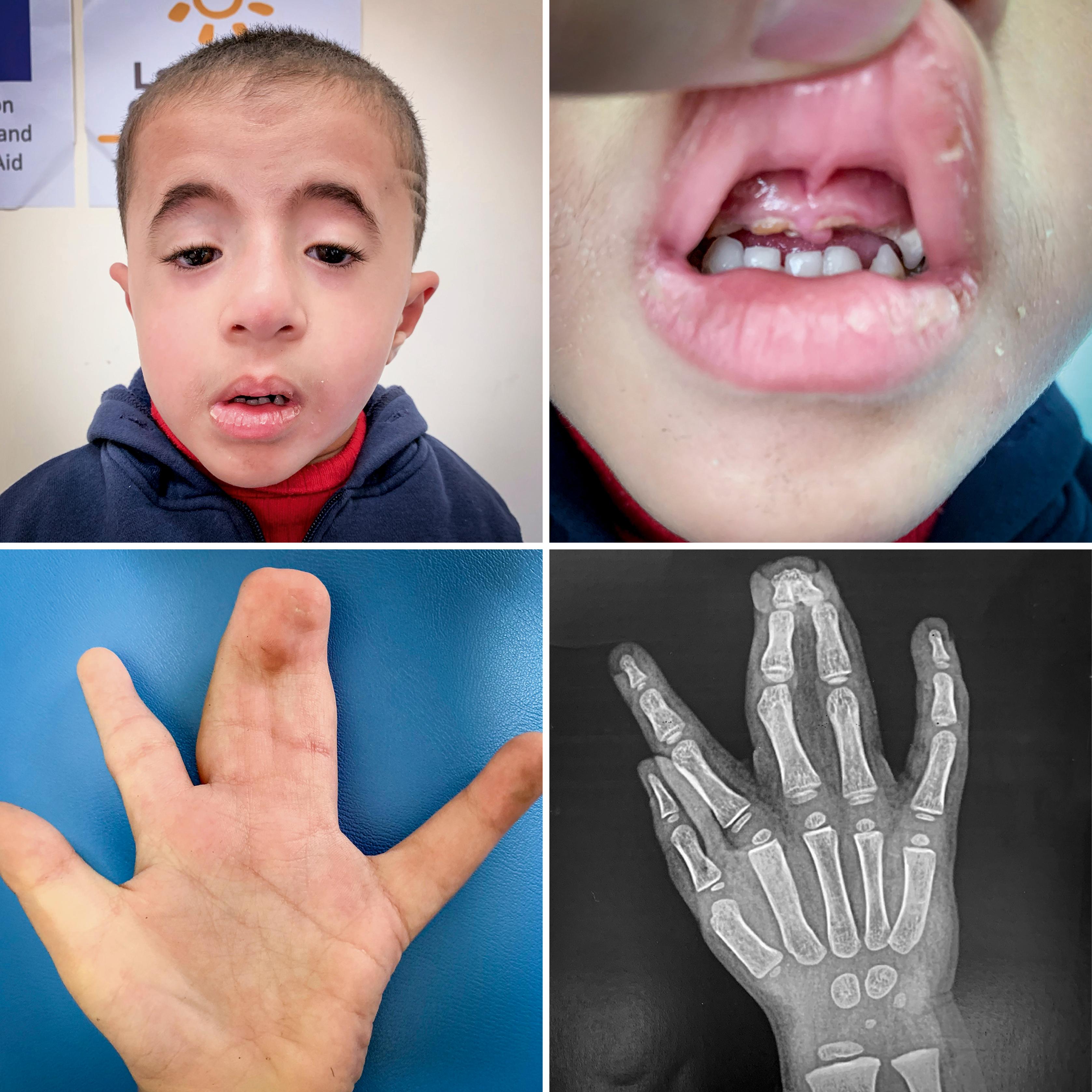
In isolated syndactyly, the third web space is the most commonly affected (55%), followed by the ring-small finger web space (25%), index-long web space (15%), and thumb-index web space (5%). In syndromic syndactyly, the involvement of web spaces is more equally distributed.
Syndactyly is a failure of apoptosis of the interdigital mesenchyme. The mesenchymal apoptosis typically proceeds from distal to proximal between gestational days 47 to 54. Skin and subcutaneous tissues are normal but the fascia bridging the interdigital space is thicker compared with normal Grayson and Cleland ligaments.
The amount of skin covering the conjoined digits is inadequate to circumferentially cover each digit individually. The circumference of two separated digits is between 20% and 30% greater than that of two connected digits. , However, in clinical practice, the lack of skin is more variable and depends on the complexity of the syndactyly and the number of digits involved in the syndactyly. Pinching the interdigital space can provide a general feeling of the amount of coronal skin and the “tightness” of the syndactyly.
In simple forms of syndactyly, the interdigital bridge is composed solely of soft tissues. In complex forms, bone comprises part of the fusion mass, and most commonly the distal phalangeal tufts are connected ( Fig. 36.2A and B) . When skeletal structures are aberrantly oriented and present between adjacent fingers, the syndactyly is classified as complicated (see Fig. 36.2C ).
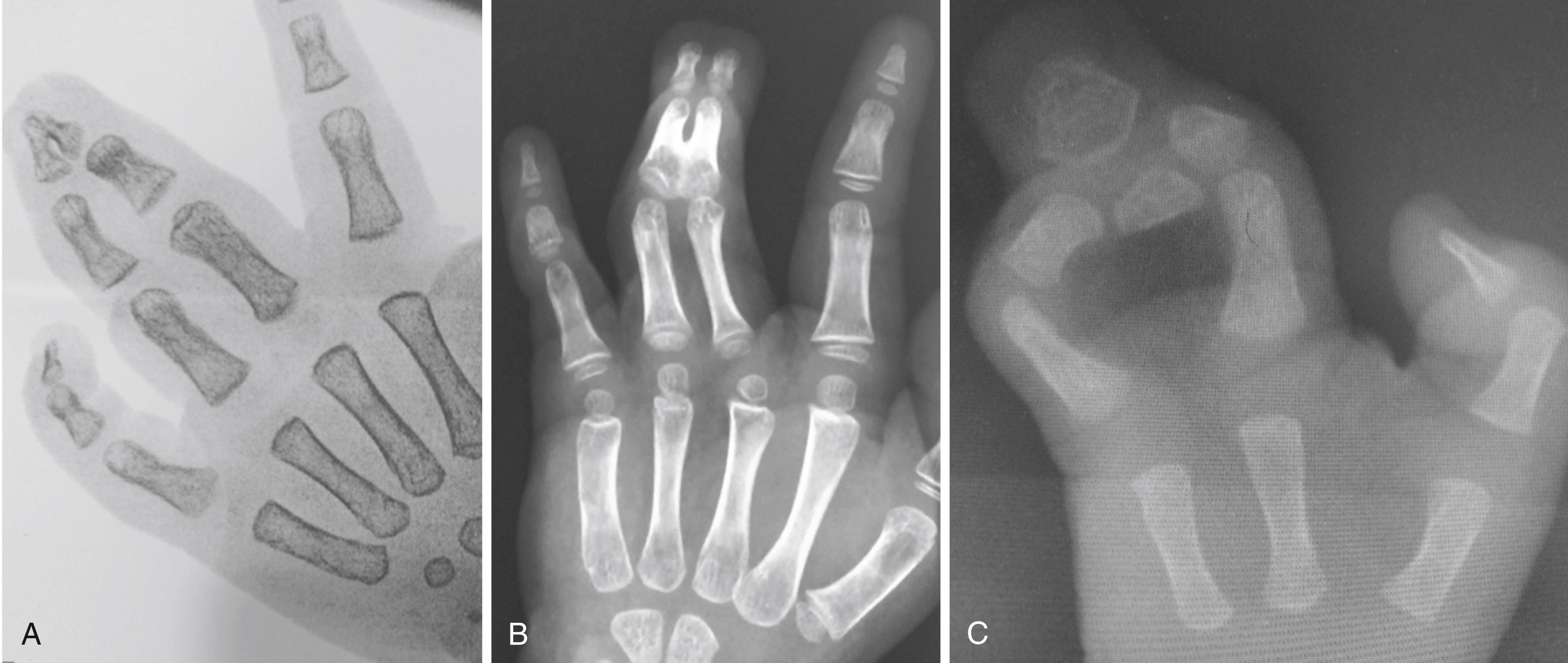
The various forms of syndactyly are classified according to the extent of digital union (incomplete versus complete) and the tissues involved (simple versus complex versus complicated). In incomplete forms of syndactyly, the skin bridge does not extend the entire length of the interdigital commissure ( Fig. 36.3 ). Conversely, complete syndactyly involves the entire web, sometimes associated with fusion of adjacent fingernails, which is called a synonychia (see Fig. 36.3 ).
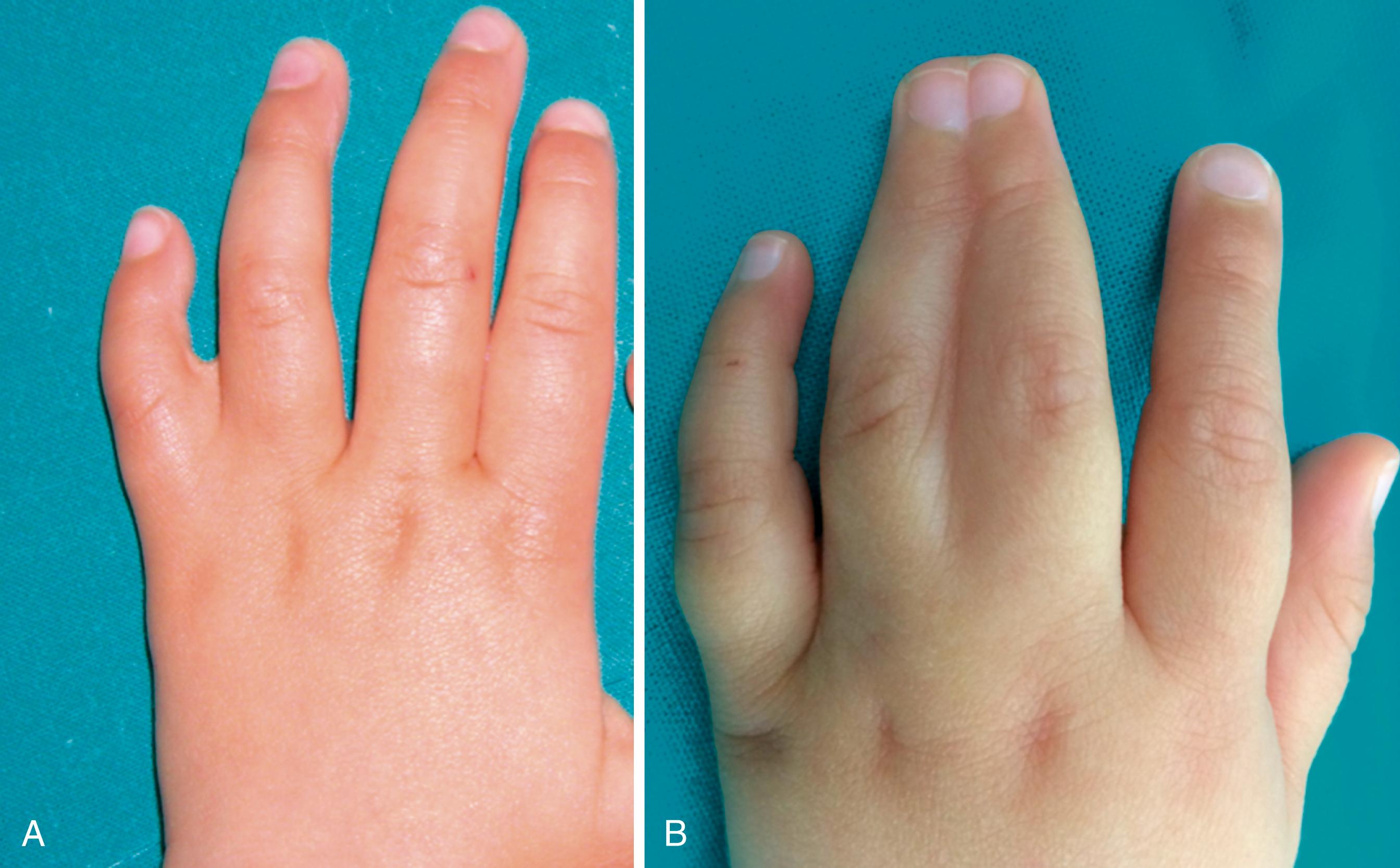
Syndactyly that involves the first (thumb-index) or fourth (ring-small) commissures or between size-mismatched fingers should be separated early, when the child is 3 to 6 months old ( Fig. 36.4 ). Early separation is recommended because the shorter digit (thumb or little finger) has a slower rate of growth and will tether the adjacent finger leading to flexion contracture and rotational deformities (see Fig. 36.4 ). Conversely, syndactyly that exists between digits with a similar longitudinal growth rate (e.g., second [index-long] and third [long-ring] commissure) can be separated later. We prefer to separate such digits when the child is between the ages of 18 and 24 months. By that point, the hand has doubled in size since birth. This facilitates surgery and produces more predictable and reproducible outcomes.
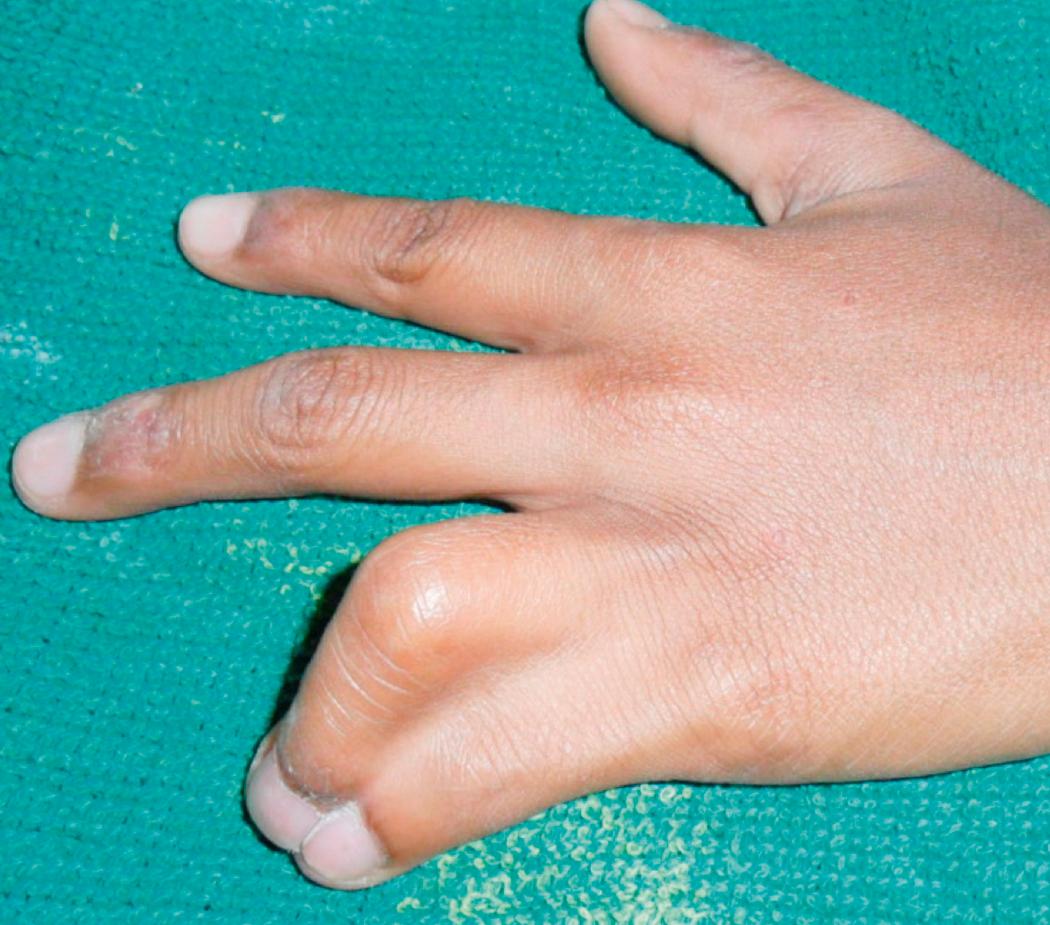
Successful surgical treatment requires understanding the principles applicable to syndactyly separation. In addition, there are varieties of techniques to address the numerous obstacles to optimize the outcome.
The main surgical principles that guide syndactyly surgery:
Surgical separation of complex or complicated forms of syndactyly that places the digits at risk for joint instability and diminished function should be avoided ( Fig. 36.5 ).

Commissure reconstruction requires supple and vascularized skin that will not interfere with digital motion in either flexion-extension or adduction-abduction. Skin grafting within the commissure should be avoided and will result in a narrow web that is prone to scar contracture and web creep. If possible, avoid placing a skin graft at the base of the finger. Techniques that recruit local skin as flaps and do not use skin grafts can be employed (see section Graftless Techniques below), which may decrease the risk of web creep , ( Fig. 36.6 ).
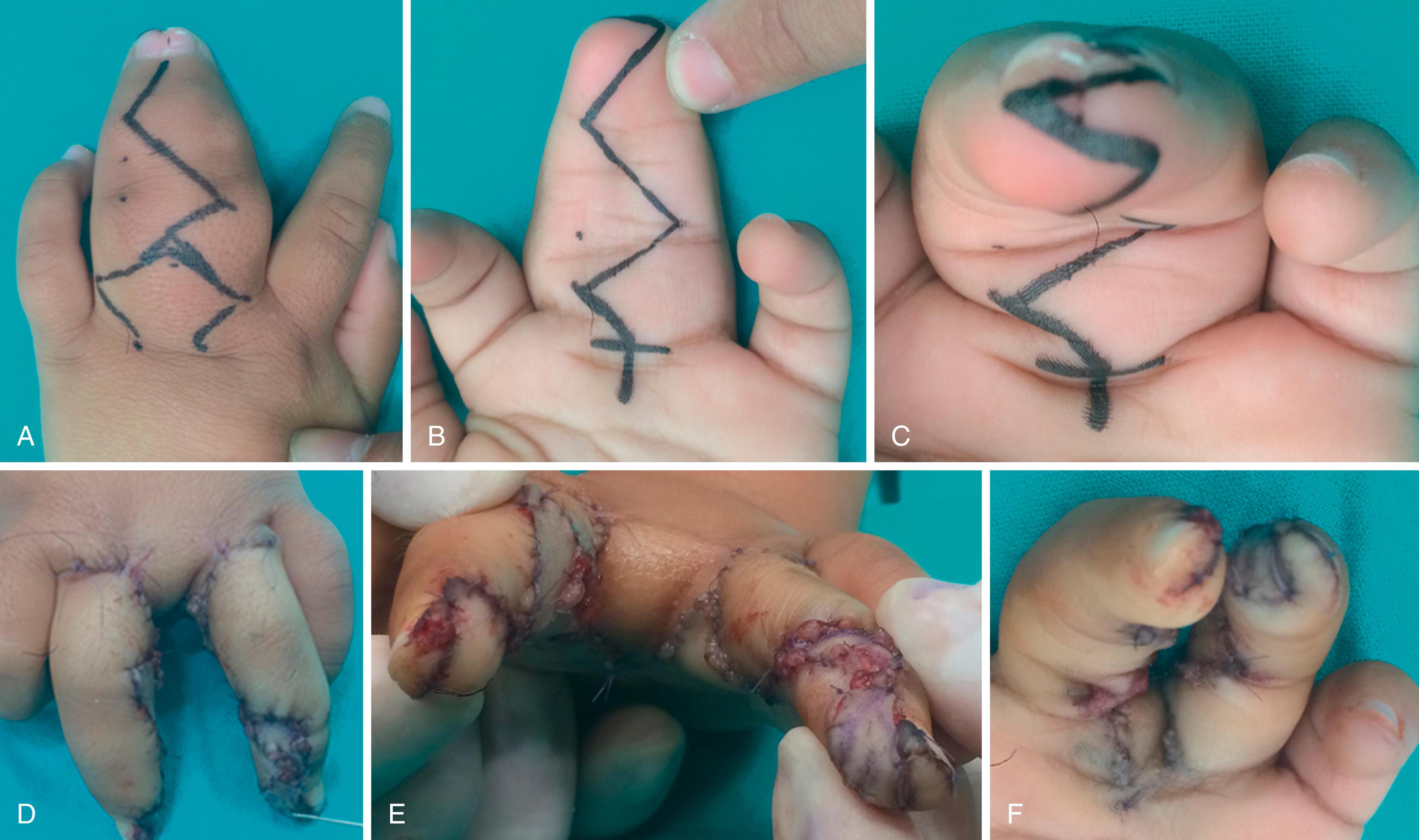
Longitudinal incisions along the digits must be avoided. Subsequent scar contracture will lead to digital flexion contractures. Thus zigzag incisions are preferred.
Removal of digital fat, while preserving the dorsal venous system, can facilitate finger closure. However, overaggressive defatting should be avoided as the child inevitably loses fat as he or she ages, and removing too much fat can result in an excessively thin finger.
Complete multiple digit syndactyly that involves two adjacent web spaces should be staged. Only one web space should be separated per surgery. This reduces the risk of digital flap necrosis and vascular complications.
Preoperative torsional and coronal malalignment of a digit will persist in the long term unless addressed at the time of surgery ( Figs. 36.6 and 36.7 ).

Regardless of the technique used to reconstruct the proximal commissure, a dorsal to volar mirrored zigzag incision is used distally to separate the fingers. Longitudinal incisions have the potential to create flexion contractures unless the scar can be carefully positioned in the midlateral axis of the finger (see Figs. 36.6 and 36.7 ).
The initial incision is made on the dorsum of the digits. Identification of the volar vessels is also from the dorsal approach, which is facilitated by spreading the interdigital space with a curved hemostat ( Fig. 36.8 ). This allows for safe vessel identification followed by digital defatting dorsal to the neurovascular bundle.
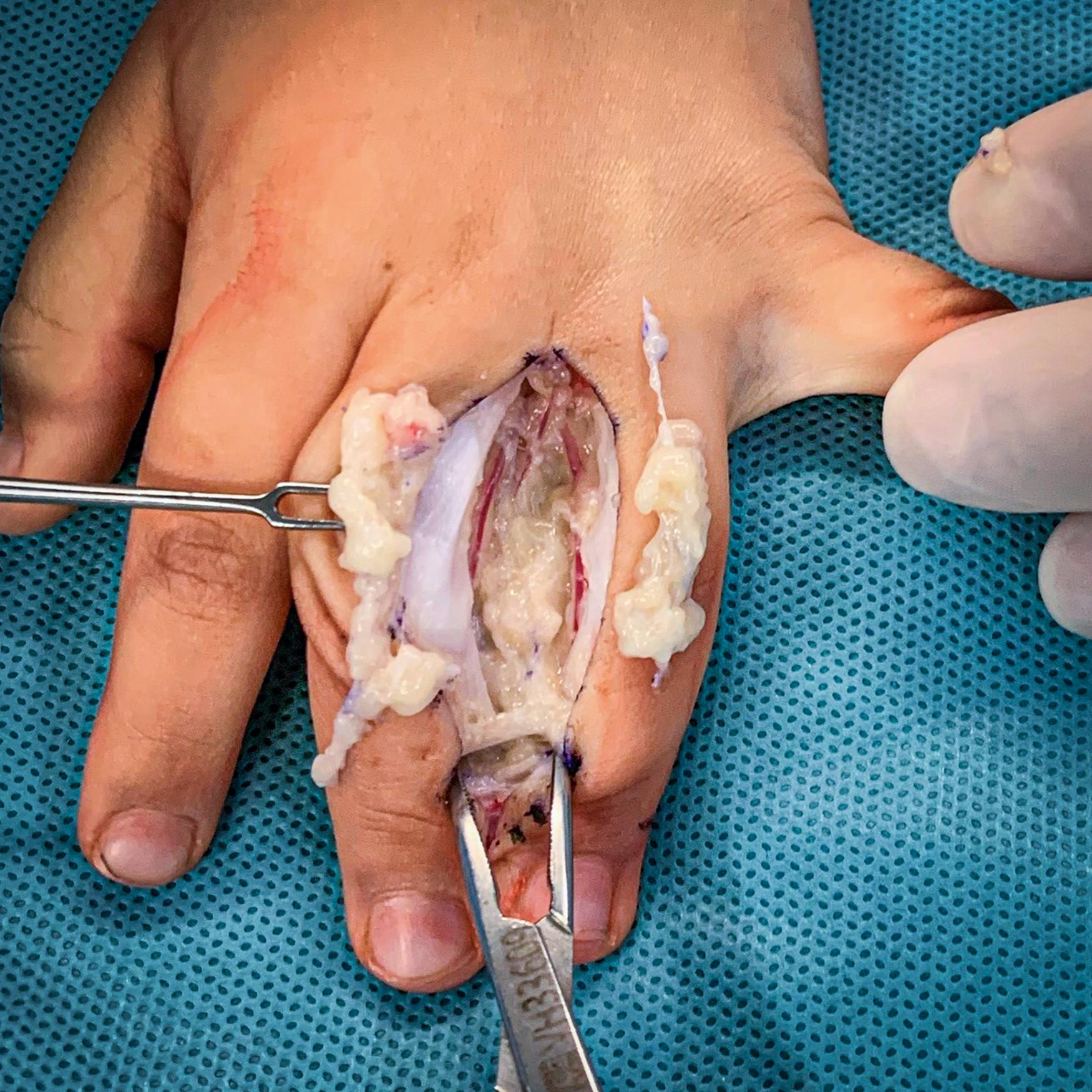
The level of division of the common digital vessels is identified. When a distal division occurs, one of the proper digital vessels can be ligated. Ligation is only done if the involved digit maintains perfusion after vessel clamping and tourniquet release. This situation is commonly encountered in the first web syndactyly where the radial proper digital artery of the index finger requires ligation to enable adequate widening of the first web space.
The standard technique, combining the use of skin flaps with full-thickness skin grafts, was first described by Cronin in 1943. Lennander pioneered the use of free skin grafts in syndactyly in 1890. Multiple variations have been described ( Fig. 36.9 ). , Full-thickness skin graft can be obtained from several locations ( Fig. 36.10 ). Grafts obtained from the volar wrist provide an ideal color and texture match with finger skin (see Fig. 36.10A ). A similar quality of skin can also be obtained from the medial arm, where a larger quantity of skin is available (see Fig. 36.10B ). Not all donor skin is optimal. Full-thickness skin graft from the groin can result in hair growth and altered pigmentation in 70% of patients.
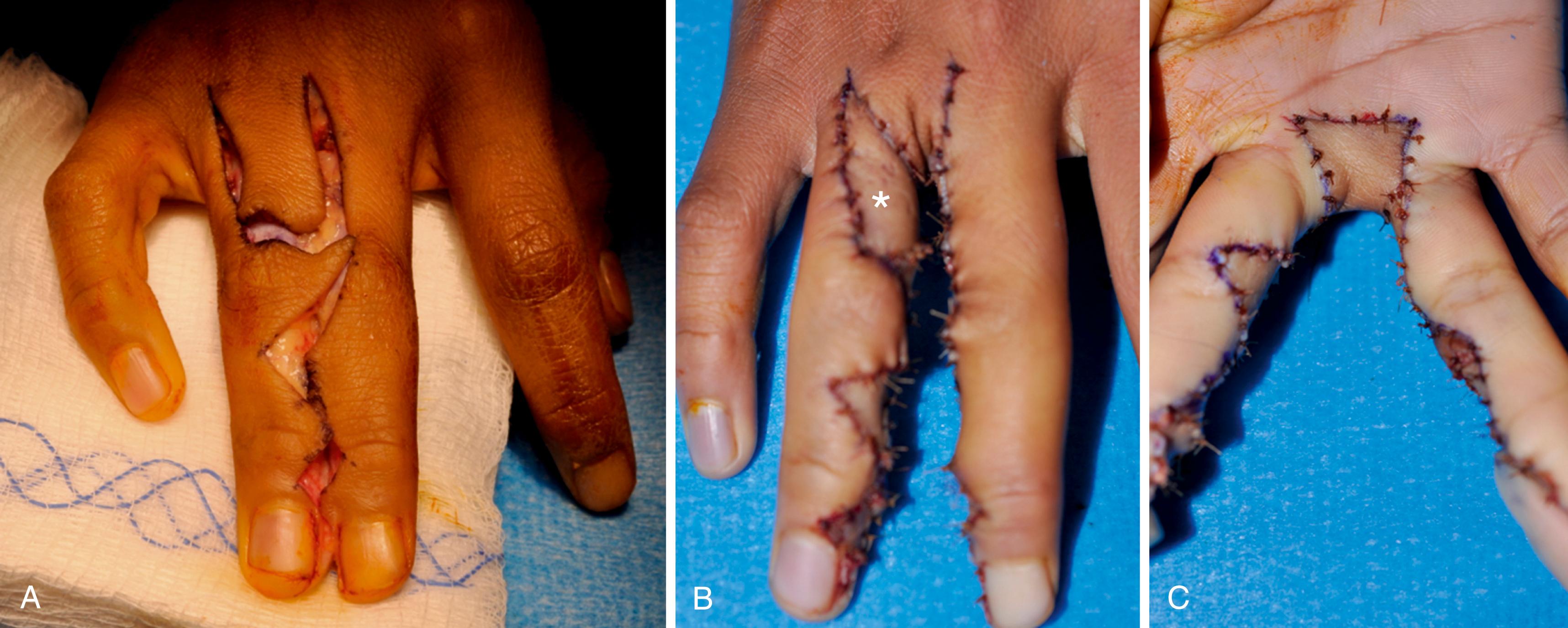
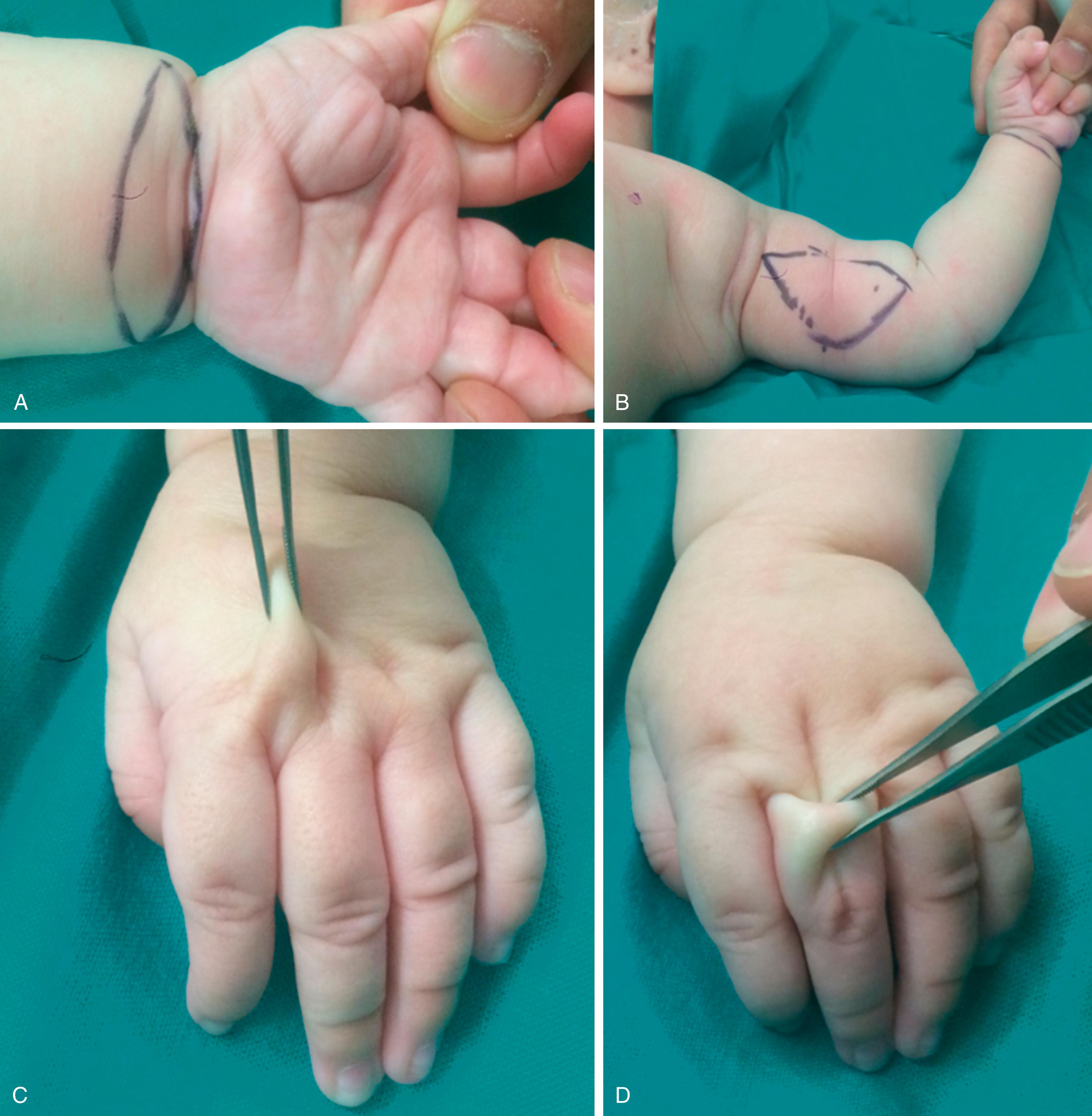
Using a hyaluronic acid scaffold for skin defects following syndactyly release has been reported recently, with excellent short-term results. Longer follow-up, however, is needed prior to uniform use to assess for delayed complications. ,
The rationale for graftless techniques lies in avoiding the complications arising from skin graft at the base of the fingers, which results in higher proportions of web creep.
Of the reported graftless techniques, all obtain extra skin from the dorsum of the hand (see Fig. 36.10C ) or the dorsum of the digits (see Fig. 36.10D ) or both. The “V-Y” dorsal metacarpal flap advances distal intermetacarpal skin to the web but may leave an unsightly longitudinal dorsal scar ( Fig. 36.11 ). In the modified seagull flap technique, excess skin is obtained from the dorsum of the proximal phalanx and shifted to the base of the fingers. Closure leaves a transverse scar over the dorsum of the digits (see Fig. 36.6 ). , ,

With graftless techniques, most cases of simple syndactyly can be separated without the need for skin graft. Complex syndactyly, however, frequently requires a skin graft at the distal portion of the digit (see Fig. 36.6D to E).
Cases of simple syndactyly with only minimal proximal involvement can be separated without the need of a skin graft using a butterfly Z-plasty ( Fig. 36.12 ).
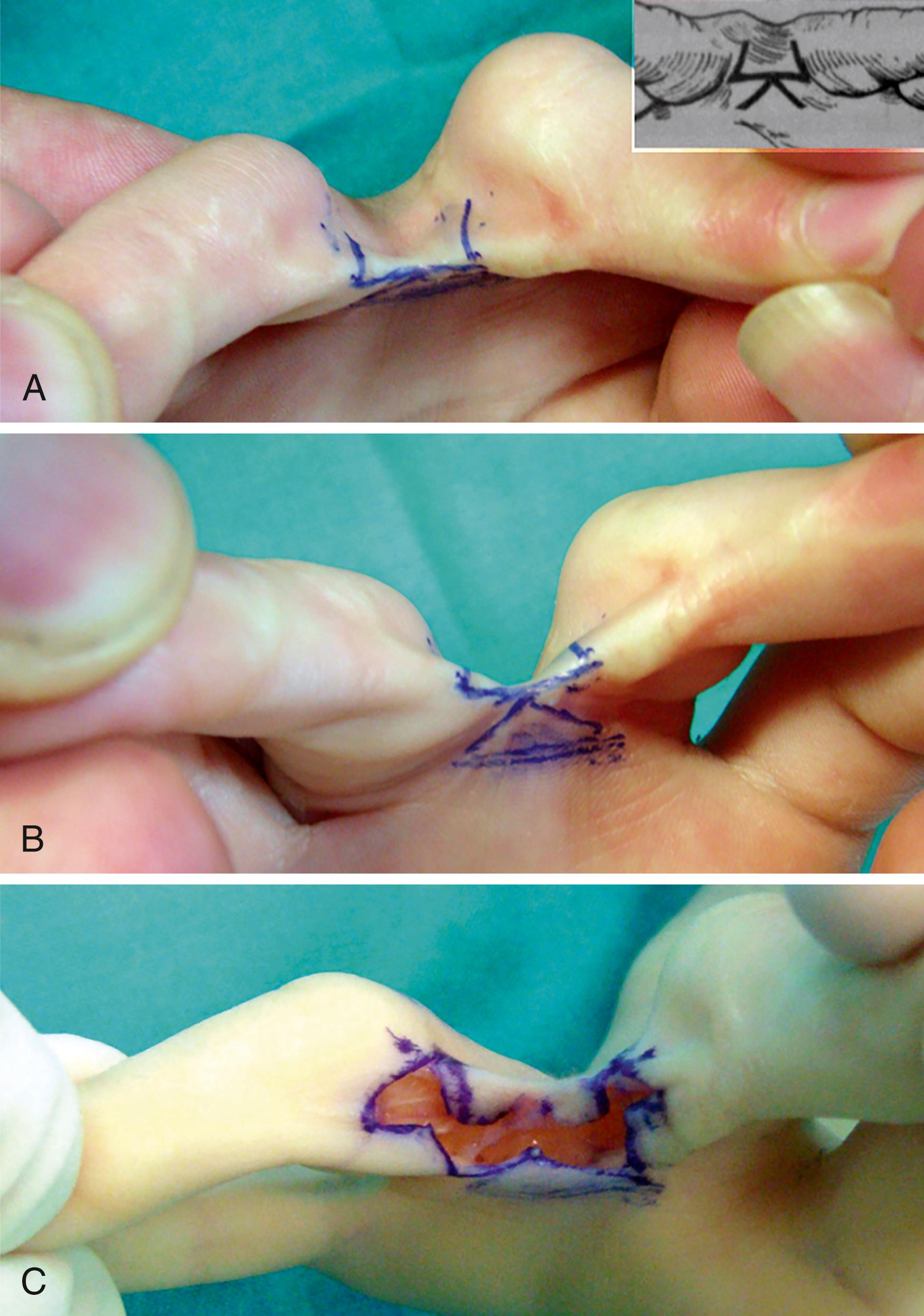
Comparative studies have confirmed that skin grafting procedures are associated with more complications (flap necrosis/graft failure, contracture, web creep, hypertrophic scarring) and a greater need for revision. , , However, graftless techniques may produce more unsightly dorsal scars leading to worse cosmetic results. , , In an attempt to overcome this disadvantage, we have described a vascularized volar intermetacarpal skin flap technique for coverage and widening of the commissure ( Figs. 36.13 and 36.14 ). When performing this procedure, release of the cutaneous septa to the digital canal and release of the lumbrical canal is mandatory to obtain the appropriate flap mobility required for distal advancement. Our short-term preliminary results are promising, but long-term follow-up is necessary prior to uniformly recommending this technique.
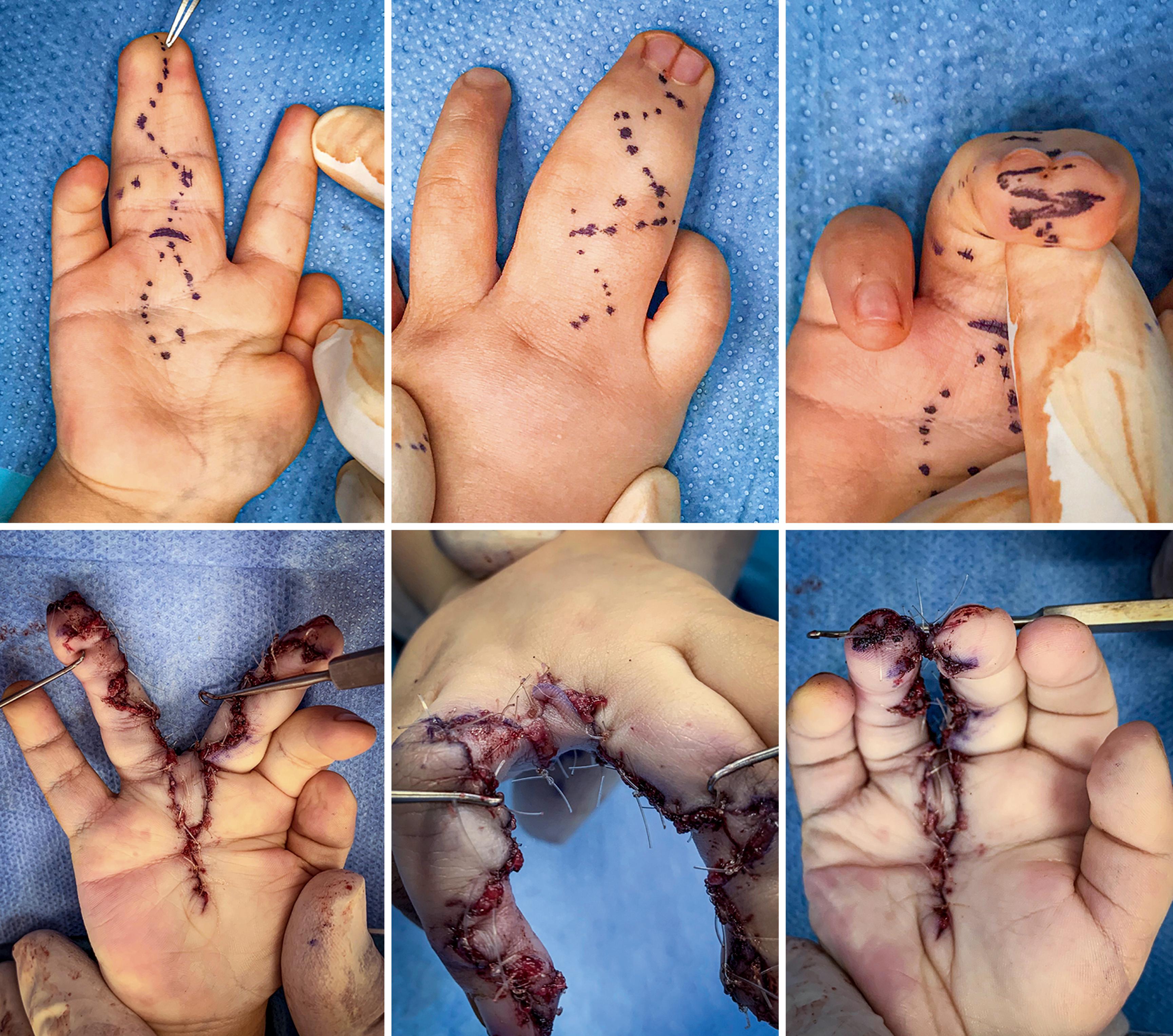
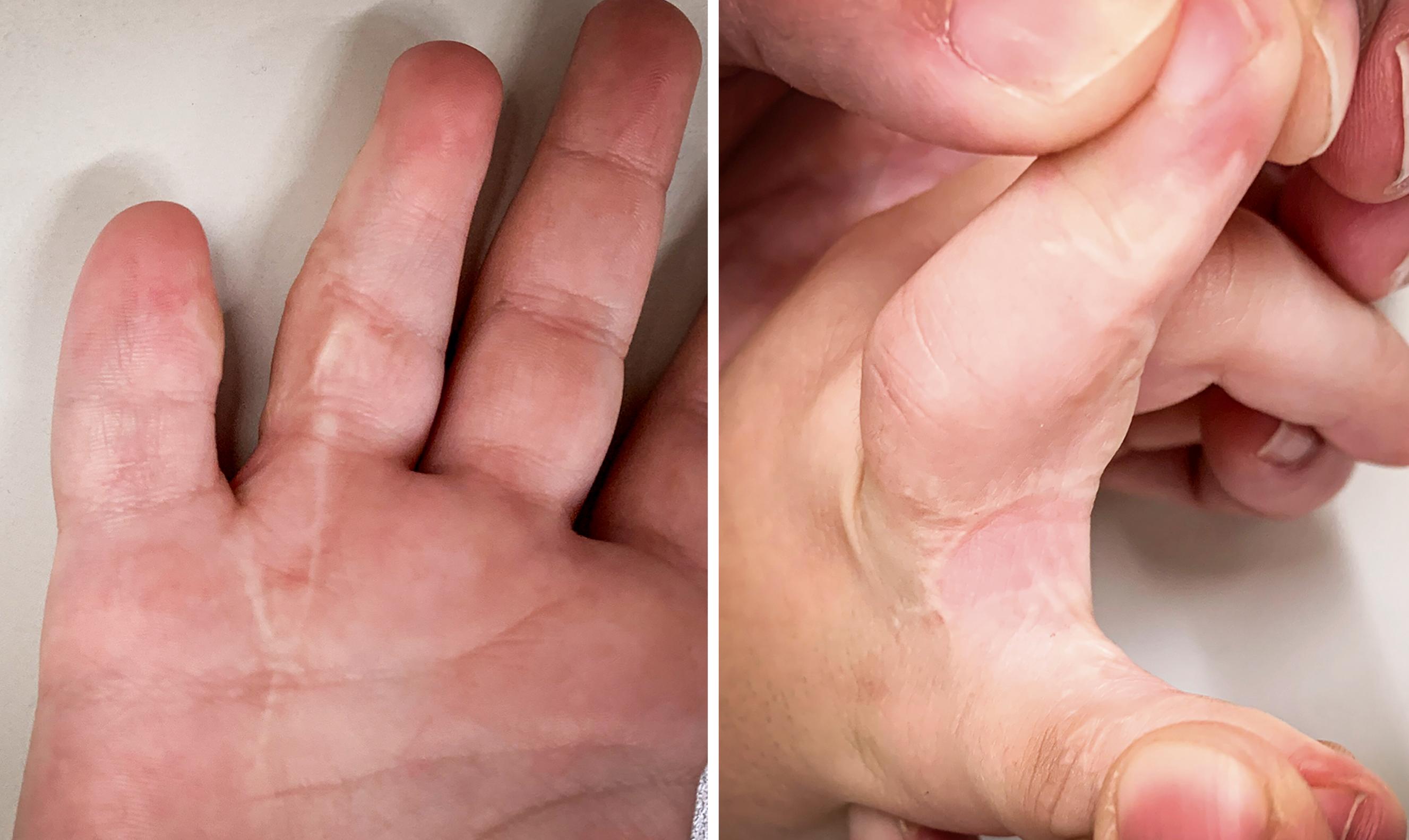
In complete syndactyly associated with synonychia, coronal skin flaps across the tip of the conjoined digits are necessary to reconstruct the nail fold ( Fig. 36.15 ; see also Figs. 36.6 and 36.13 ). Long-term nail problems are common if the nail fold is inadequate.
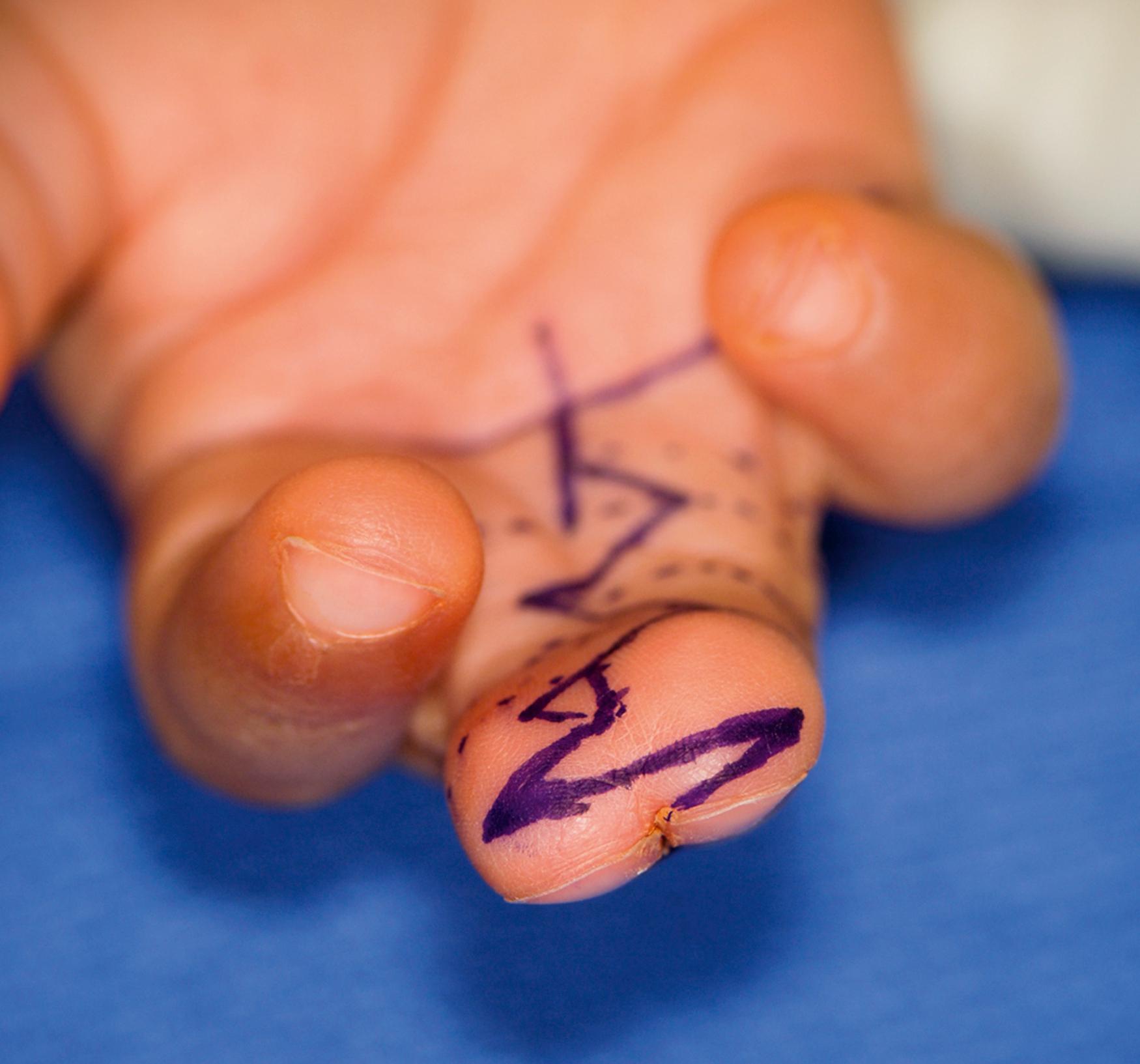
Syndactyly involving the first web space requires early separation. Surgery is performed at approximately 6 months of age, both to avoid tethering deformities and to allow the development of thumb pinch. Reconstruction of the first web has unique challenges and may necessitate utilization of different surgical techniques. A straightforward option is the Ghani flap, a Buck-Gramcko modified dorsal rotation advancement flap ( Fig. 36.16 ). This flap provides substantial deepening and widening of the web space. In some cases, this flap may still provide insufficient skin, and a wider first web can be obtained using forearm pedicled flaps or free vascularized flaps ( Fig. 36.17 ). ,

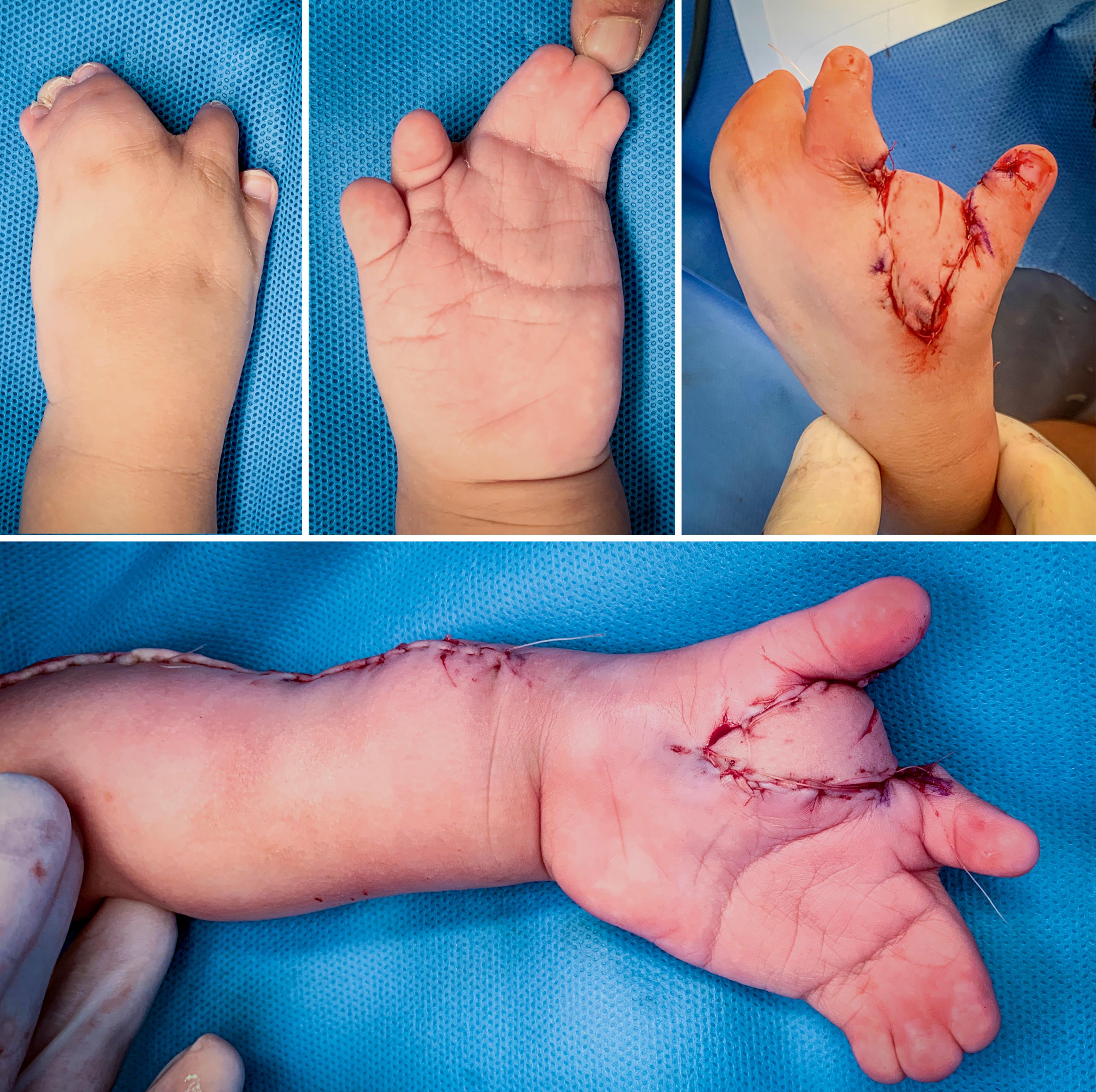
Acute intraoperative complications are uncommon. Vascular problems can occur because of too tight skin closure. Stitch release and supplemental skin grafting usually resolves this problem.
In contrast, long-term problems are common. Following classic grafting techniques, web creep rates have been reported as high as 8%. An additional 42% of patients experienced web thickening without creep (see Fig. 36.7B ). Severe contractures can also occur (see Fig. 36.7C ). ,
Residual deformities are especially common in complex syndactyly cases and are associated with poorer esthetic outcomes. Most separated digits in cases of complex syndactyly ultimately develop long-term lateral deviation or rotational deformities, as well as notable nail deformities (see Figs. 36.6F and 36.7 ).
Finally, keloid formation is common in separated digits that exhibit concomitant macrodactyly ( Fig. 36.18 ). , Surgeons need to be aware of this problem as keloid formation in this subset of patients can be prevented with methotrexate therapy.
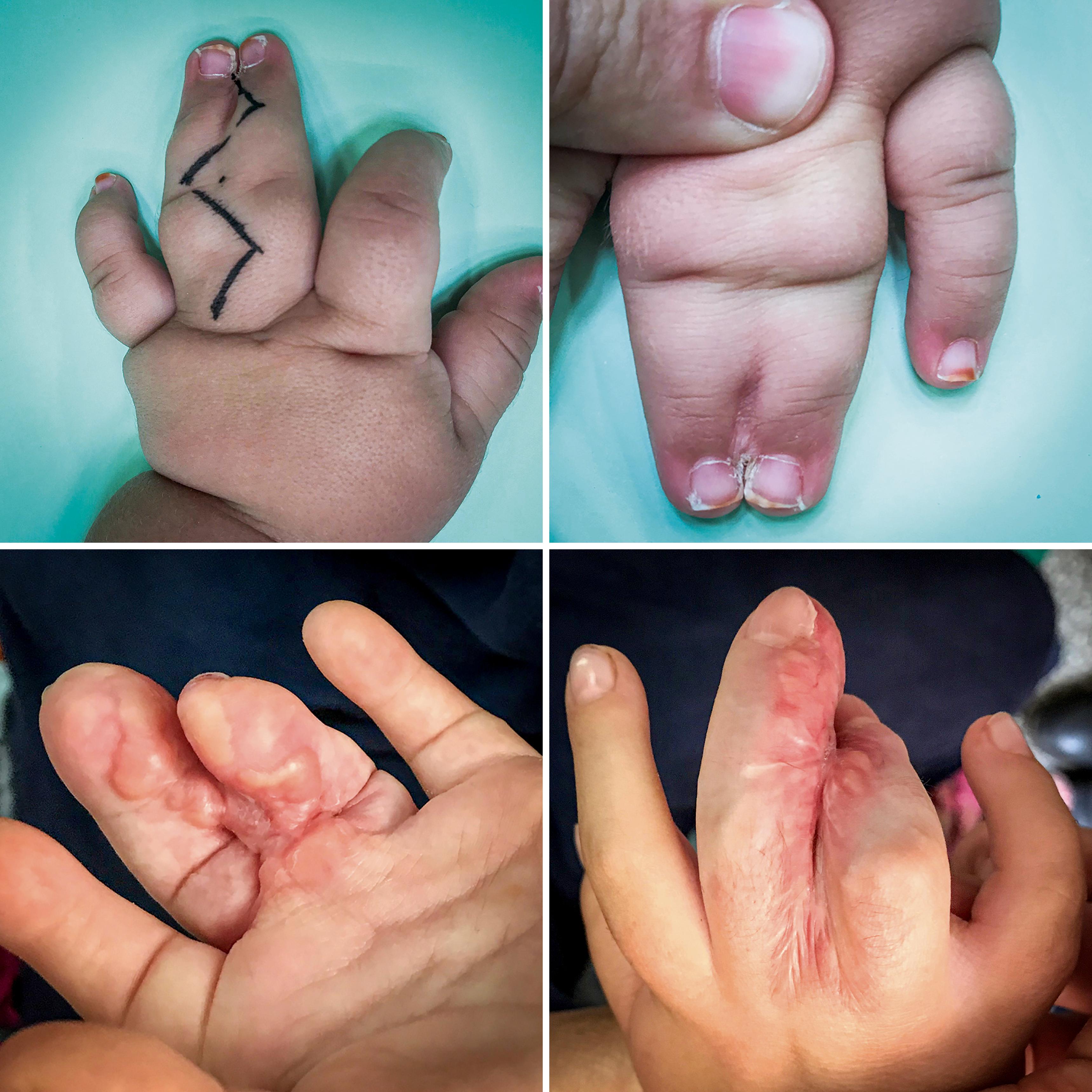
Second and third commissures are separated after the age of 18 months. First and fourth commissures are separated between 3 and 6 months of age. Our preferred skin grafting technique is the method described by Bauer (1956) and modified by Flatt. The commissure is reconstructed using a large trapezoidal dorsal random-pattern skin flap (see Fig. 36.9 ). Full-thickness skin graft is obtained from the volar wrist or from the medial arm if more extensive surface coverage is needed. A zigzag incision is preferred for digit separation with Buck-Gramcko coronal skin flaps for nail fold reconstruction.
When possible, we prefer using graftless techniques for two main reasons: (1) potential decrease of the risk of web creep, and (2) surgery is less time consuming. We have preferentially used a modified seagull technique (see Fig. 36.6 ). Currently, we are also using the above described volar intermetacarpal vascularized flap (see Fig. 36.13 ). We are monitoring for a longer-term follow-up prior to recommending this technique over the seagull technique.
Our preferred technique for first web syndactyly reconstruction is the Ghani flap or modified dorsal rotation advancement flap (see Fig. 36.16 ). For additional widening, we use a pedicled radial forearm flap to reconstruct the first web (see Fig. 36.17 ). The donor forearm defect can be closed without skin graft.
Proper postoperative dressings are an essential part of syndactyly surgery. In young children, the hand dressing is reinforced by immobilization in an above-the-elbow plaster or soft fiberglass cast (Scotchcast, 3M, St. Paul, MN). The elbow is flexed to 100 degrees to prevent inadvertent removal. A supracondylar mold helps to keep the cast in place. The dressings are removed 3 weeks after surgery. The wounds are protected until they are dry and healed. Therapy is not usually required.
CRS is associated with syndactyly (acrosyndactyly and pseudosyndactyly), transverse defects (amputations), constriction rings, dorsal cutaneous nubbins, hypertrophic fibrous subcutaneous tissue, and first web contracture. , Many of these features can be present in the same patient with CRS ( Fig. 36.19 ).
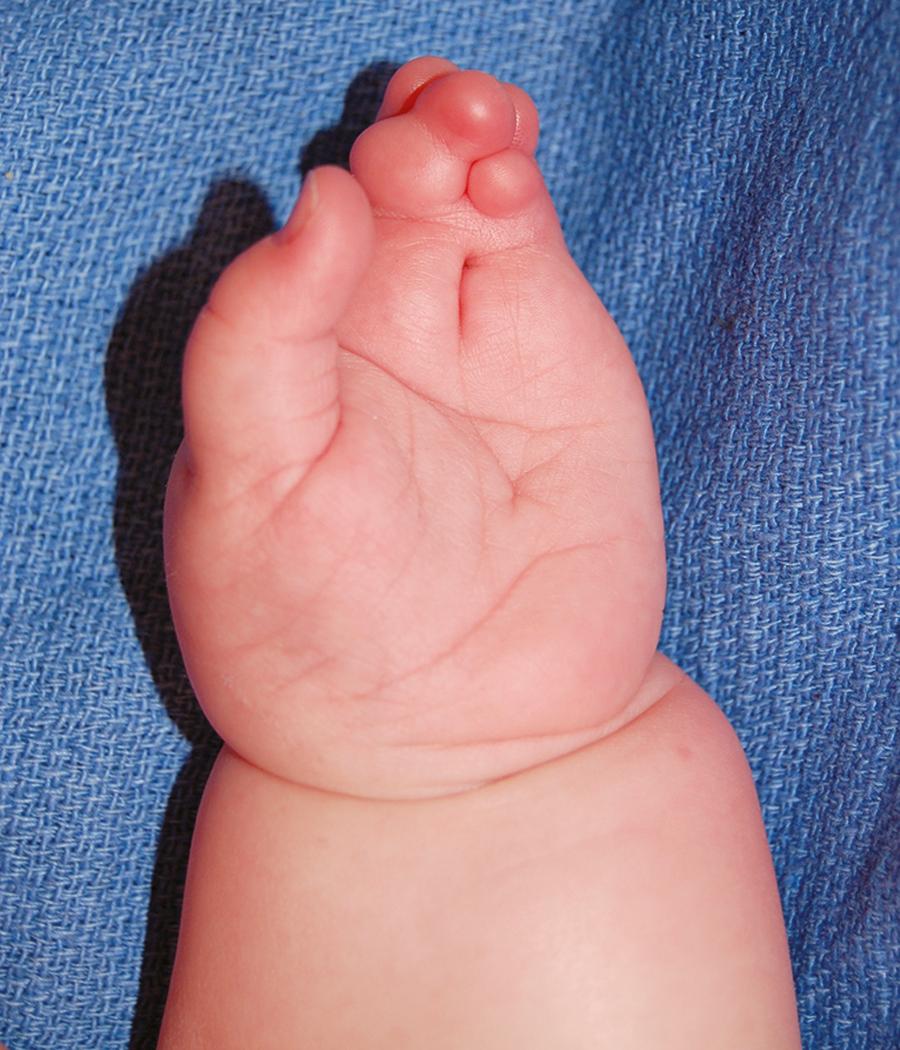
In unilateral presentations, amniotic band syndrome may be confused with symbrachydactyly. The absence of nail remnants in the foreshortened amputated fingers, the presence of constriction rings, and the symmetric size of the hand are hallmarks of a CRS.
Soft tissue connections in CRS are discontinuous, creating three distinct patterns , :
Acrosyndactyly: The tips of the digits are conjoined distally, producing a jumble of fingertips ( Figs. 36.20 and 36.21 ).
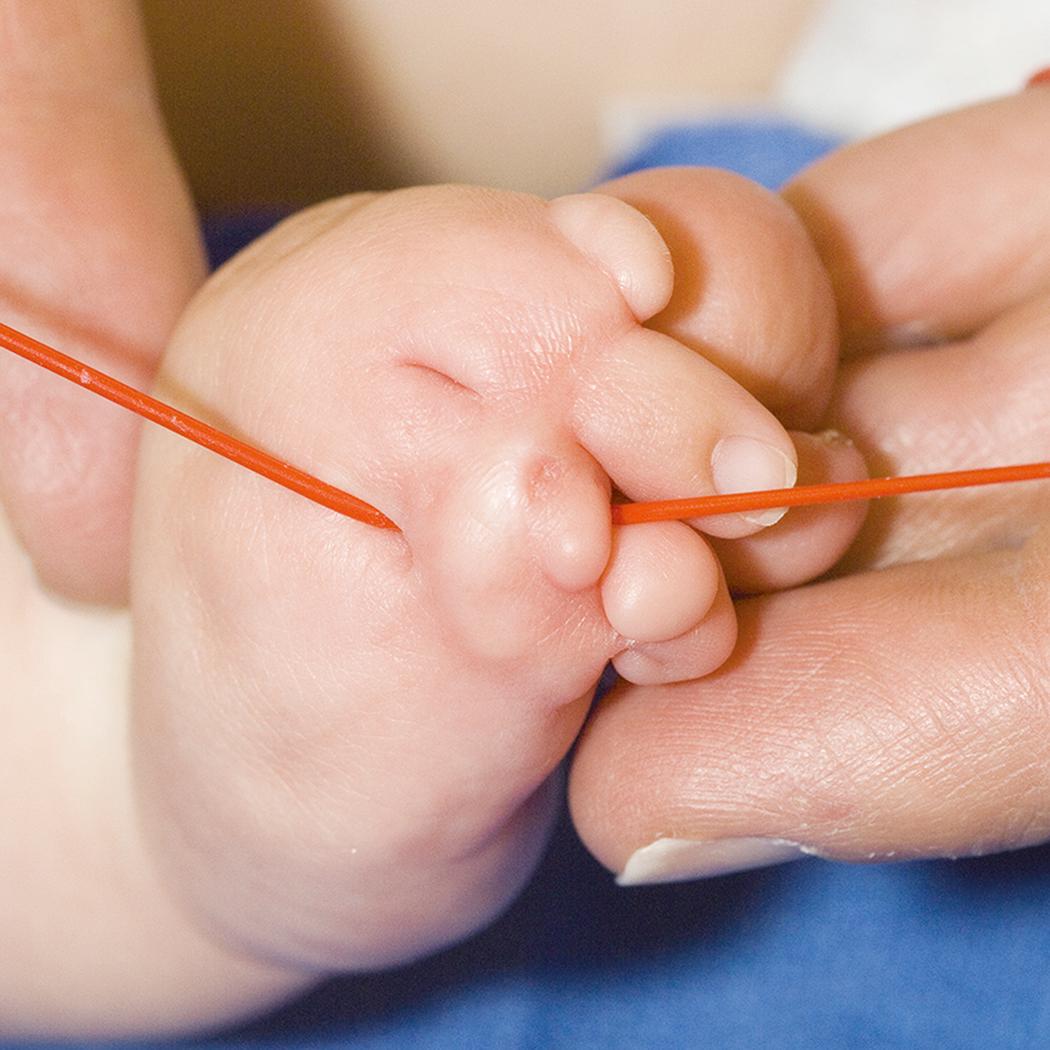
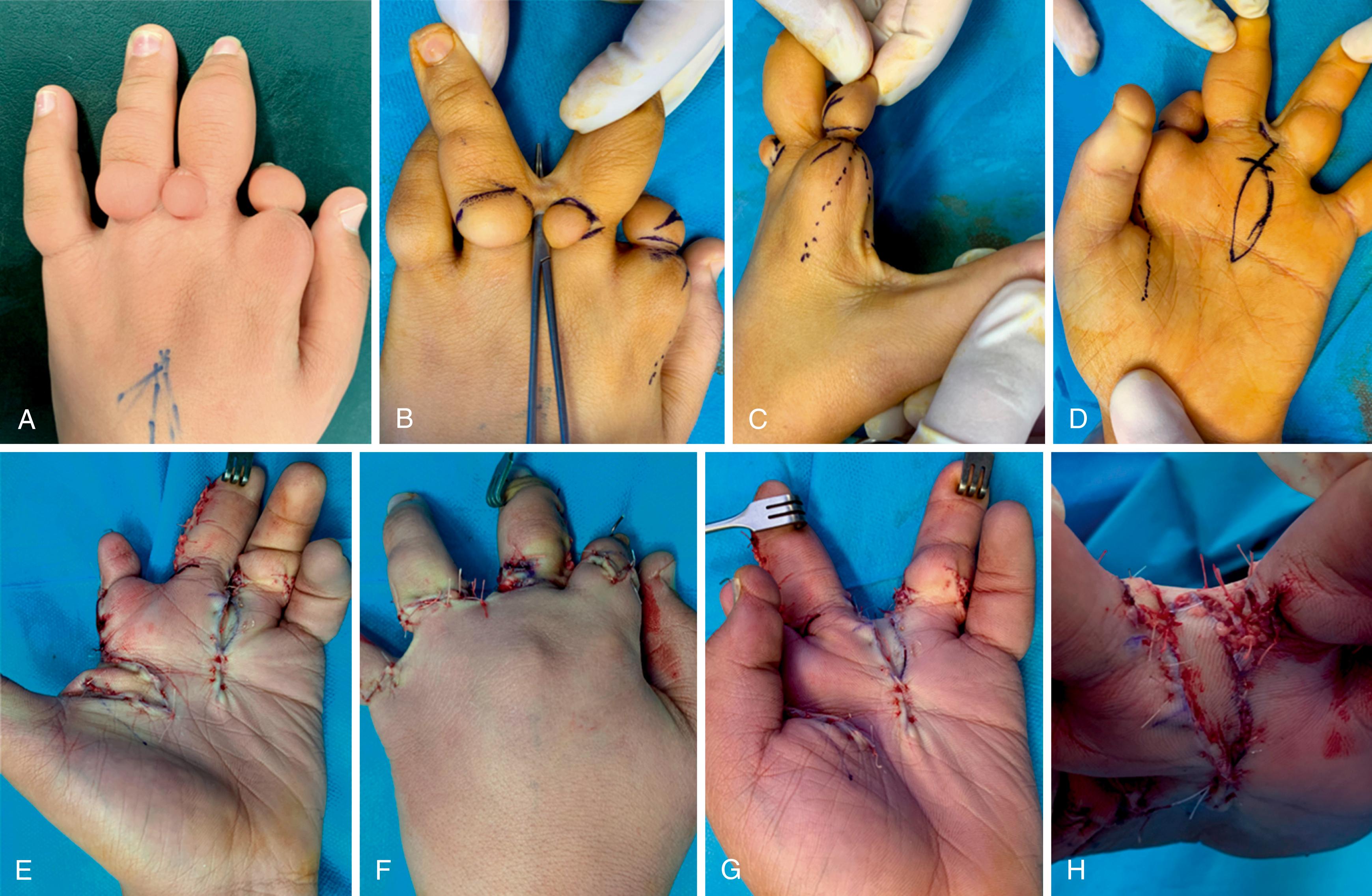
Pseudosyndactyly or incomplete syndactyly: The syndactyly is interrupted or fenestrated by transfixing sinuses of varying size (see Figs. 36.20 and 36.21 ).
Nonadjacent finger syndactyly: distal syndactyly between two noncontiguous digits without syndactyly with the adjacent digit.
Syndactyly management (technique, timing) in CRS follows the previously discussed principles. Sinus tracts are excised or maintained as a part of the finger resurfacing depending on their size. Debulking, through excision of the hypertrophic subcutaneous tissue, is complex and often leads to “swollen,” unsightly digits (see Fig. 36.19 ). Excision of dorsal cutaneous nubbins is performed simultaneously with syndactyly release (see Fig. 36.21 ). Constrictions can also be treated at the same time. In these cases, a dorsal hemiband excision and Z-plasty is performed. A one-stage excision can be performed in instances where the band is less deep and the vascular structures are visualized and intact. In cases with severe distal edema, amputation may be necessary. Very distal constrictions, when associated with acrosyndactyly, may also be better treated with amputation. In some cases of acrosyndactyly with narrow soft tissue connections, separation can be performed very early and allowed to heal via secondary intention.
Apert syndrome combines a craniosynostosis and midfacial hypoplasia with complex syndactyly of the hands and feet. Apert syndrome is genetic and secondary to a mutation in the fibroblast growth factor receptor type 2 (FGFR2) gene located on chromosome 10q. Several other acrocephalosyndactyly syndromes have been identified; however, the hand deformities are less complex. Apert syndrome has other upper limb manifestations, including shoulder and elbow dysplasia with stiffness, which usually do not require surgical intervention. Prior to hand surgery, craniofacial anomalies should be addressed by neurosurgery and maxillofacial teams, usually around 3 months of age to improve anesthesia safety.
The hand deformity is classified according to the involvement of the first web space and the appearance of the central mass ( Table 36.1 ). The Apert hand has several key problems that must be addressed including syndactyly (including the first web), synonychia, symphalangism and/or finger stiffness, thumb brachydactyly and clinodactyly, and ring-small intermetacarpal synostoses (type II to III) ( Figs. 36.22 and 36.23 ). ,
| Type | First Web | Central Mass | Fourth Web |
|---|---|---|---|
| Type I Obstetrician hand or spade hand |
Incomplete simple syndactyly | Digital mass flat in palmar plane. Good metacarpophalangeal joints with variable degree of symphalangism at interphalangeal joints |
Incomplete simple syndactyly |
| Type II Mitten hand or spoon hand |
Complete simple syndactyly | Digital mass forms palmar concavity with splaying of metacarpals proximally and tight fusion of fingertips distally with synonychia of central digital mass | Complete simple syndactyly |
| Type III Hoof hand or rosebud hand |
Complete complex syndactyly | Thumb incorporated into mass, which is tightly cupped; synonychia of all digits apart from the small finger; skeletal abnormalities of index ray Complicated by paronychial infections and maceration of palmar skin |
Simple syndactyly, usually with metacarpal synostosis of fourth and fifth metacarpals |

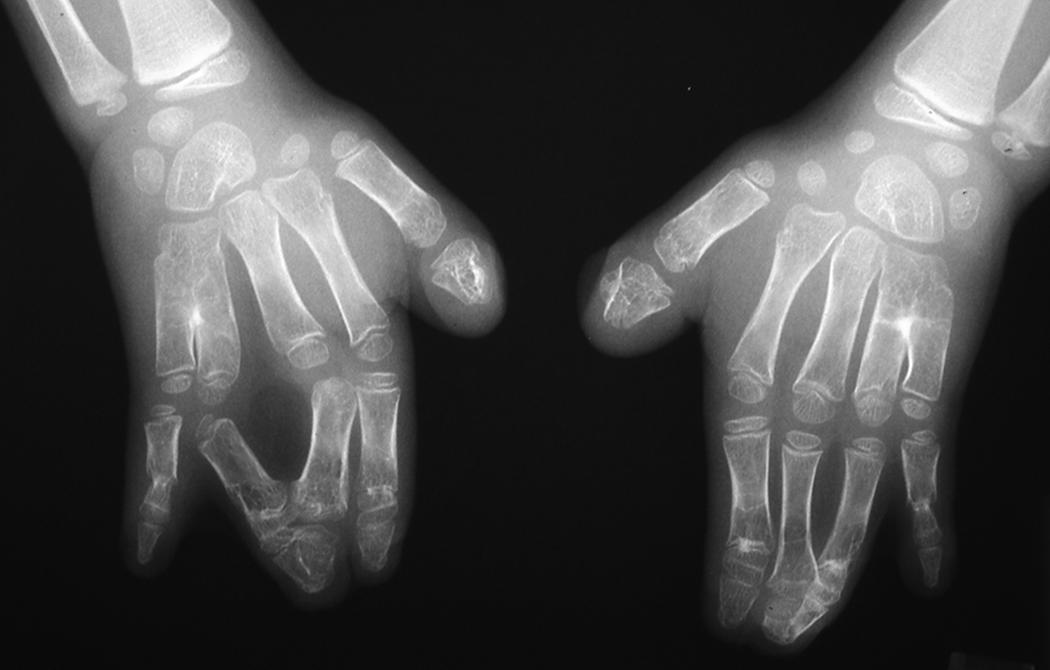
There are many different treatment approaches to the Apert hand with variability between surgeons regarding timing and extent of management. , , The goal is to complete separation of the digits before 2 years of age to allow for unimpeded growth and functional hand development. Although one stage reconstruction has been described, most surgeons have adopted staged reconstructive strategies. The first stage is performed around the age of 9 months with subsequent surgeries occurring every 3 to 6 months.
Reconstruction of first web space is the first priority and is performed during the first stage. The goal is to position the thumb ray in 45 degrees of abduction. This requires release or lengthening of tight structures including the skin, fascia, intrinsic muscles, and carpometacarpal (CMC) joint ( Fig. 36.24 ). Type I and II hands first web space skin deficits can be addressed with a four flap Z-plasty. Type III or II with severe first web space contractures require a dorsal advancement rotation flap. Authors have proposed preliminary tissue expansion on the dorsum of the hand. , A pedicled or free flap is also an option to provide a wide first web reconstruction ( Figs. 36.25, 36.26, and 36.27 ).
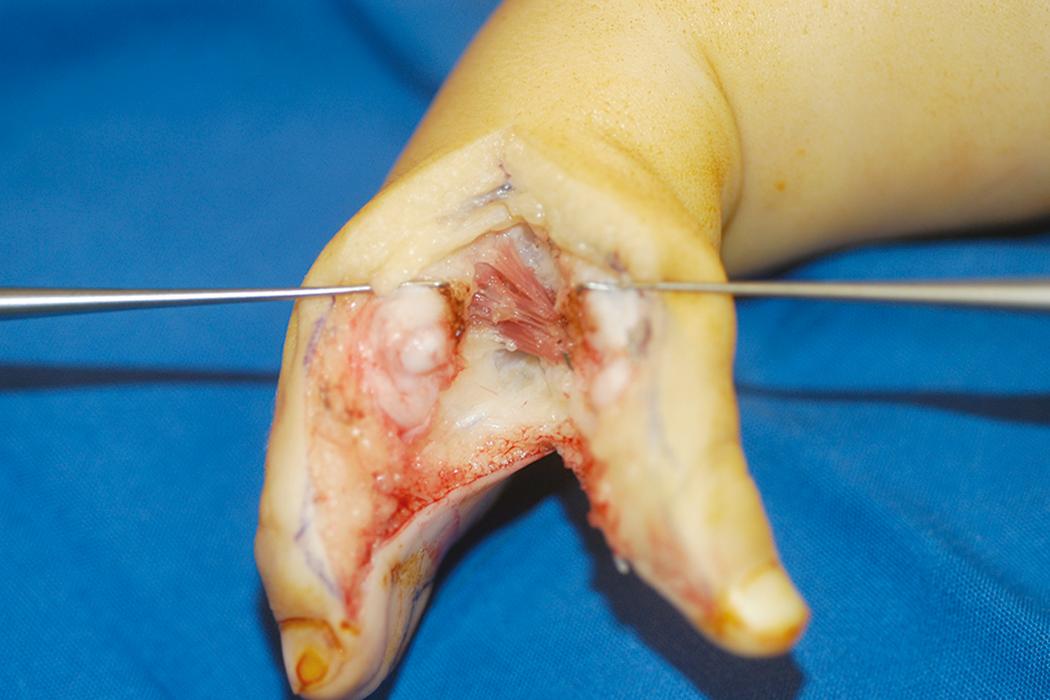
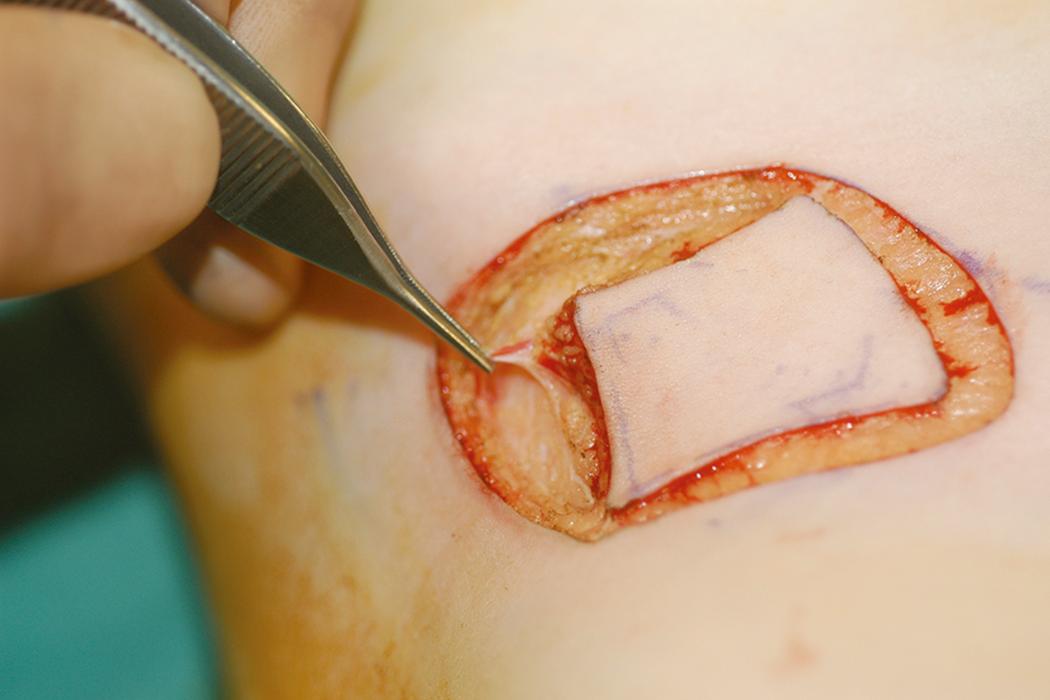
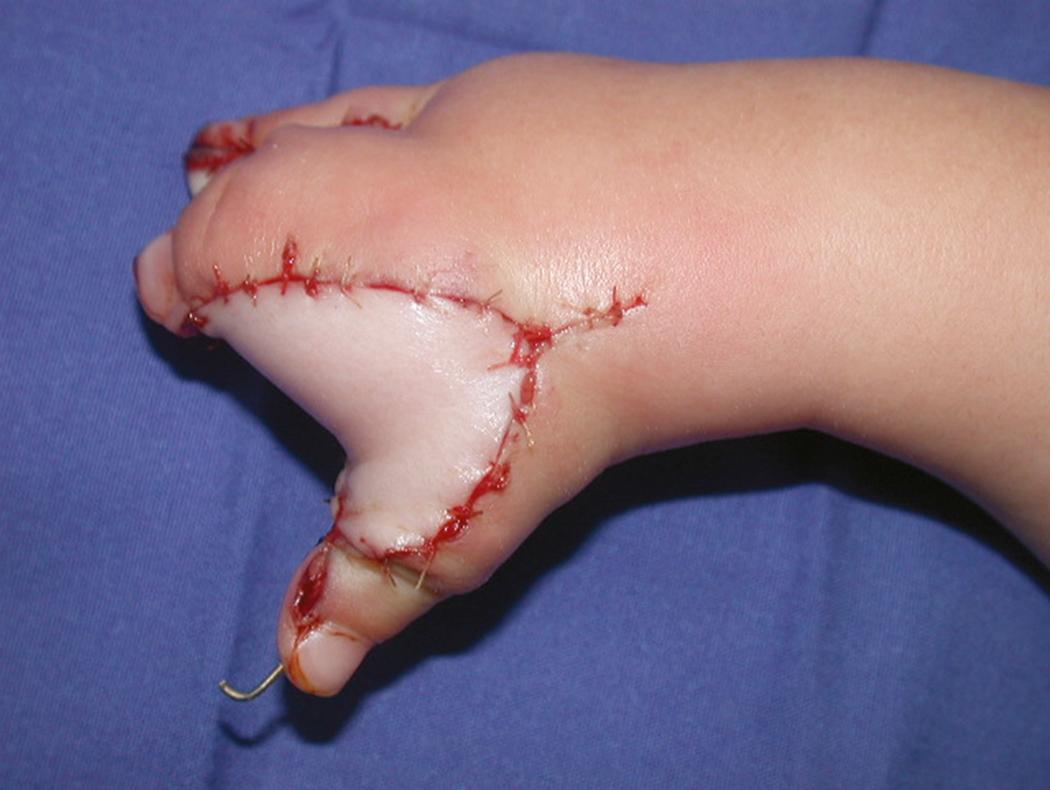
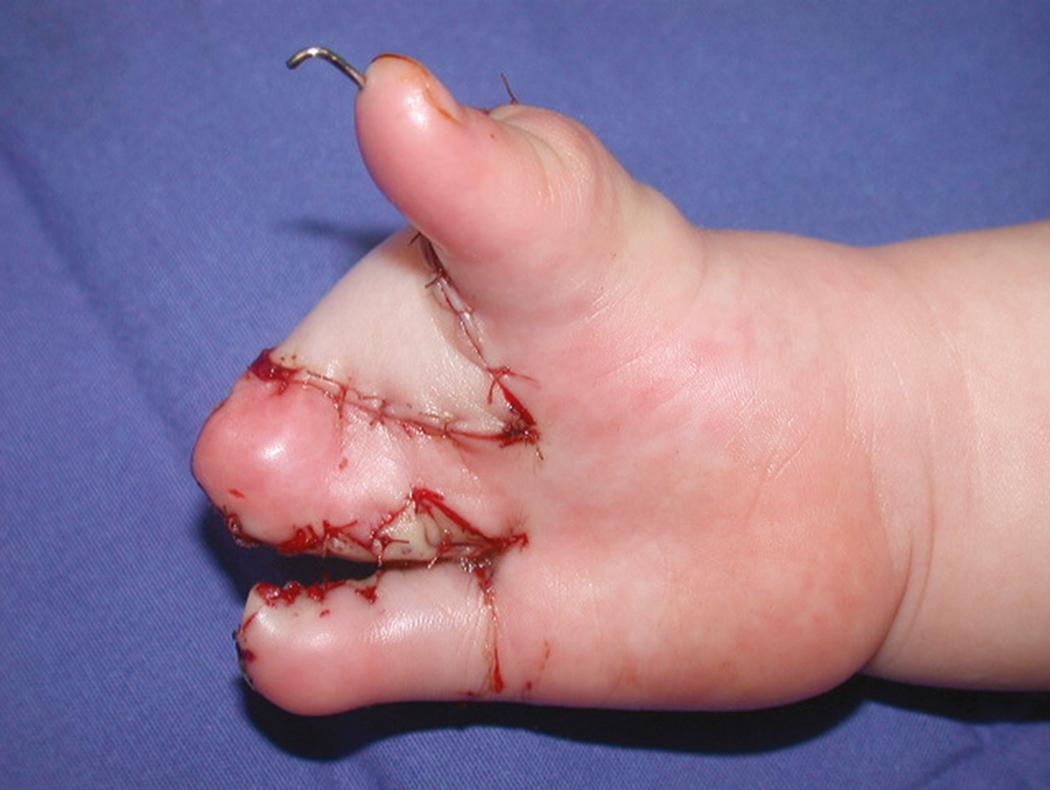
A distally curved central bone mass, if present, is also osteotomized into the phalangeal components during the first stage via a fish mouth incision. This converts the hand into the flat “spade” configuration (type I deformity) and allows for untethered growth of the central digits. ,
The order and number of finger syndactyly releases and the need for ray resection depend on the type of deformity and surgeon preference. In the type III Apert hand, a ray resection of the index, long, or ring ray are all possibilities. , , The advantage of resecting the index ray, especially if radially deviated, is increasing the width of the first web space. The advantage of resecting the ring ray and the intermetacarpal synostosis is increasing small finger motion. There are no comparative functional studies between four- and three-fingered Apert hands.
An option in the Apert hand is a dorsal commissure flap combined with longitudinal incisions. This technique separates the fingers and leaves a longitudinal scar. However, the fingers are uniformly stiff in extension at the interphalangeal (IP) joints and do not develop flexion contractures. The soft tissue envelope of the Apert hand is usually extremely tight and fails to stretch (may be related to the fibroblast growth factor mutation). Separation results in extensive skin defects requiring coverage. This large amount of skin graft can be obtained from the lower abdomen and/or the medial arm. Soft tissue expansion in the coronal plane with an external fixator (Cube fix) to avoid skin grafting has been reported with good results.
Most authors address thumb clinodactyly during the second stage. Thumb deformity is the result of delta-shaped and often fused phalanx and the abnormal insertion of the abductor pollicis brevis (APB) onto the distal phalanx causing metacarpophalangeal (MCP) joint radial deviation. Reconstructive options include:
A radial Z-plasty with opening wedge osteotomy and bone graft of the thumb phalanx. Bone graft sources include the iliac crest, any resected metacarpal, or bone from the resected intermetacarpal synostosis. Some authors perform this surgery after the age of 6 years to decrease recurrence rate.
Release of the abnormal APB insertion with reinsertion in the proximal phalanx combined with realignment osteotomy. ,
The small finger ray is typically the least dysplastic and most mobile digit. However, intermetacarpal synostosis between the small and ring fingers lessens the mobility and prohibits the small finger from reaching the thumb (type II and III Apert hands). Synostosis resection and interposition improves small finger motion for opposition. , The risk of synostosis recurrence is decreased when resection is performed after 5 years of age.
Syndactyly may involve only the soft tissue (simple) or include bony connections (complex).
Atypical forms of syndactyly are labeled complicated and involve either convoluted soft tissue abnormalities or a hodgepodge of abnormal bones. Many atypical configurations occur in conjunction with a variety of syndromes.
Mild incomplete syndactyly that does not interfere with function does not require treatment. In contrast, simple syndactyly of any considerable degree warrants surgical reconstruction of the web space for improved function and appearance.
Border digits (thumb/index finger and ring/small finger web spaces) have marked differences in their respective lengths and should be separated within the first few months of life. This prevents tethering of the longer digit, which results in a flexion contracture and rotational deformity.
Syndactyly that combines digits of relatively equal length (e.g., long-ring finger web space) will not develop a deformity during growth. Separation may be delayed until the child is older and the hand larger to facilitate surgical reconstruction.
Surgical reconstruction of complete syndactylies should only include one side of an affected digit at a time to avoid vascular compromise of the skin flaps, digit, or both.
Surgical reconstruction of the commissure must be free of skin graft.
Skin graftless techniques avoid using skin graft at the base of the fingers and potentially decrease the risk of web creep.
Complex syndactyly is more challenging to treat, especially as the degree of bony union increases.
Hand surgery is not performed until cranial issues have been addressed for a safe anesthesia.
Type I and II Apert hands are less urgent compared with a type III hand. Surgery is staged with the first stage at 9 to 12 months (first and third commissures) and second stage 6 months later (second and fourth commissures), ring metacarpal ray resection if necessary (type III hand).
For the first web space, we prefer a four-flap Z-plasty for type I to II and Ghani flap for type II to III. For the second to fourth webs, we prefer straight incisions and dorsal rectangular flap. Skin graft is obtained from the medial arm.
Thumb clinodactyly correction and synostosis resection are addressed after the age of 5 years.
Poland syndrome is a nonhereditary congenital difference. There is a male and right-sided predominance. Subclavian artery disruption in embryogenesis has been postulated as etiology. A similar cause has been implicated in Klippel-Feil syndrome, Möbius syndrome, and Sprengel deformity (16%). Dextrocardia is present in left-sided cases.
There is unilateral hypoplasia or absence of pectoralis musculature. The sternocostal head of pectoralis major muscle is absent in 30% of the cases, and the entire pectoralis major is absent in 70%. The chest wall deficit is associated with ipsilateral hand anomalies in 60% of the cases ( Fig. 36.28 ). ,
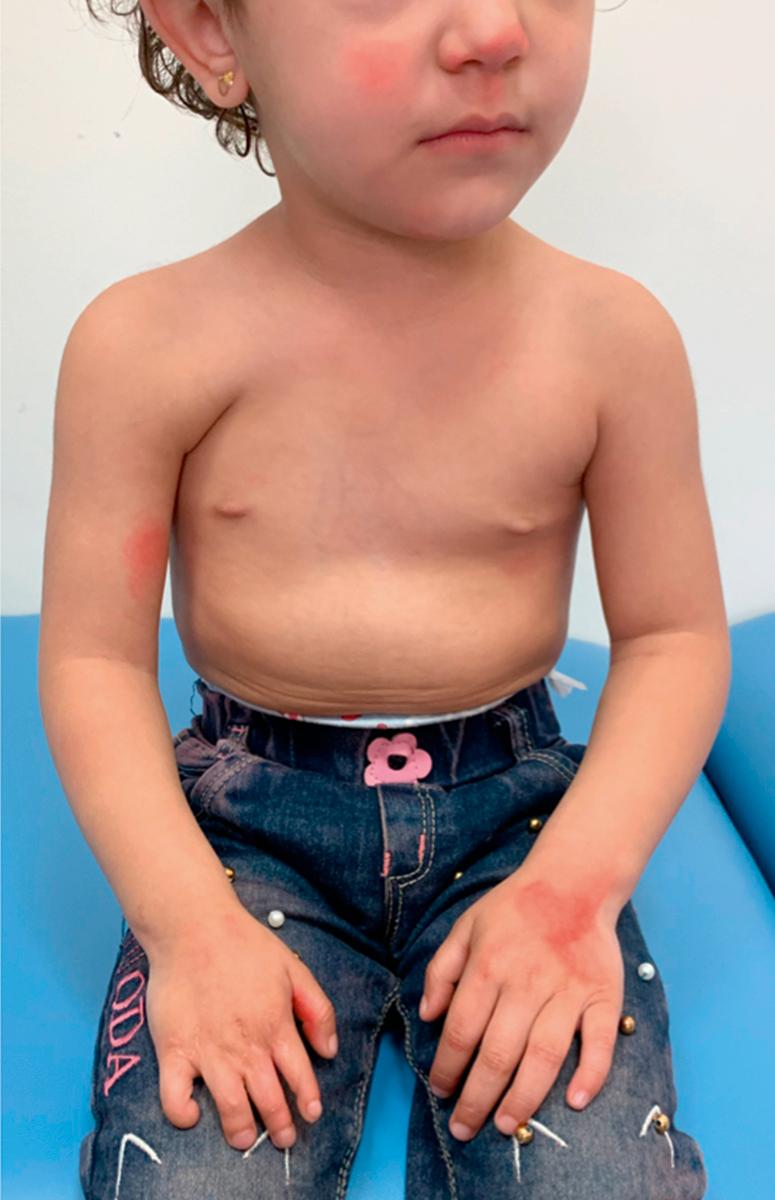
There can be other concomitant deformities including unilateral nipple hypoplasia/agenesia (40%), breast hypoplasia/agenesia (20%), thoracic wall anomalies (30%), and periscapular muscles hypoplasia (latissimus dorsi, serratus anterior, infraspinatus, supraspinatus, deltoid muscle) (20%).
The most common hand deformity is short finger-type symbrachydactyly with mild thumb involvement including a first web contracture and a smaller hand (60%). Other more severe types of transverse deficiencies can also be seen. Forearm and arm size discrepancy is present in 40% and 10% of cases, respectively.
Syndactyly separation follows the aforementioned principles regarding timing and techniques. One stage reconstruction may be possible in short incomplete syndactyly using graftless techniques ( Fig. 36.29 ).
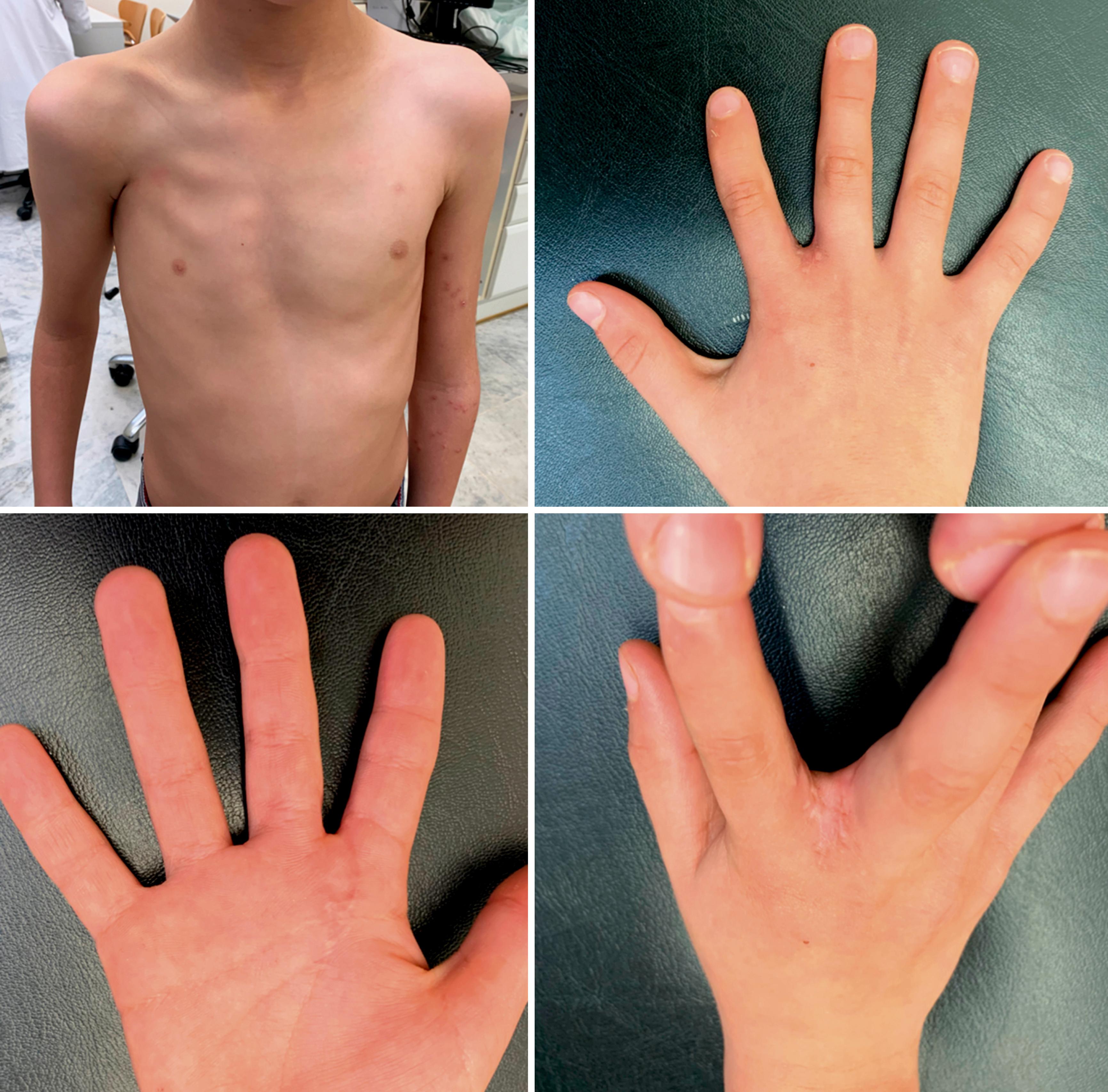
Syndactyly release in children with simple syndactyly usually results is a natural-appearing web commissure with pliable skin, unrestricted function, and minimal web creep over time. However, the results may be complicated by contracture or scar hypertrophy, which downgrades the function and outcome. Web creep may require additional surgery to reposition the web. The results following syndactyly release for complex or complicated cases are less predictable. Underlying factors directly affect outcome including the extent and number of bony connections, the presence of a synonychia, concomitant symphalangism, and any associated anomalies. The surgical technique and the surgeon are also variables that directly affect outcome.
Ulnar or postaxial polydactyly prevalence and presentation varies between races. In African Americans, the prevalence is estimated to be 1 in 150 live births. In these patients, the ulnar polydactyly is frequently inherited in an autosomal dominant pattern with variable penetrance, and only 1% are associated with syndromes. In Caucasian individuals, the incidence is 10 times less than in the African American population, and 10% have an underlying syndrome (e.g., chondroectodermal dysplasia or Ellis–van Creveld syndrome). Approximately 75% of cases are bilateral, and in two-thirds of cases, the feet are also involved. , Arabic population prevalence and presentation are between Caucasian and African populations.
The supernumerary digit is either well developed (type A, 25%) or rudimentary and pedunculated (type B, 75%) according to Temtamy and McKusick ( Fig. 36.30 ). , Several type A ulnar polydactyly subclassifications have been proposed as the presentation is variable ( Fig. 36.31 ).


Caucasian individuals are referred to the geneticist for study and counseling. A small nubbin, considered a postaxial element type B, can be safely removed by tying the base with a suture or vessel clip in the nursery ( Fig. 36.32 ). The digit will turn gangrenous and autoamputate. However, this method results in a residual bump in 40% of individuals, with an average diameter of 2 mm (range, 1 to 6) (see Fig. 36.32 ). , A ligature results in torsion of these type B digits, resulting in painful edema or ischemia ( Fig. 36.33 ). The type B can be safely removed in the office using local anesthesia and a bipolar electrocautery.
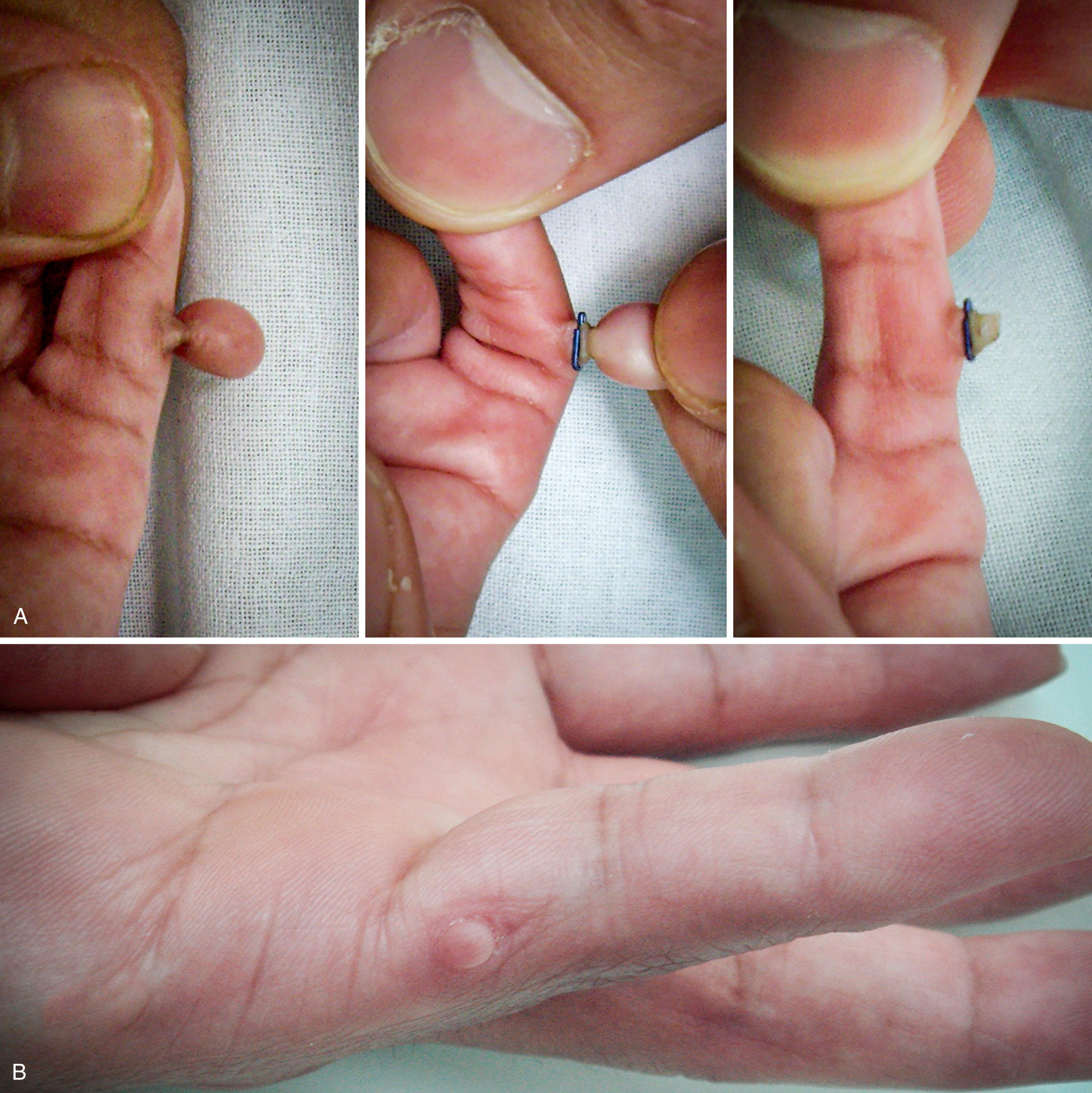
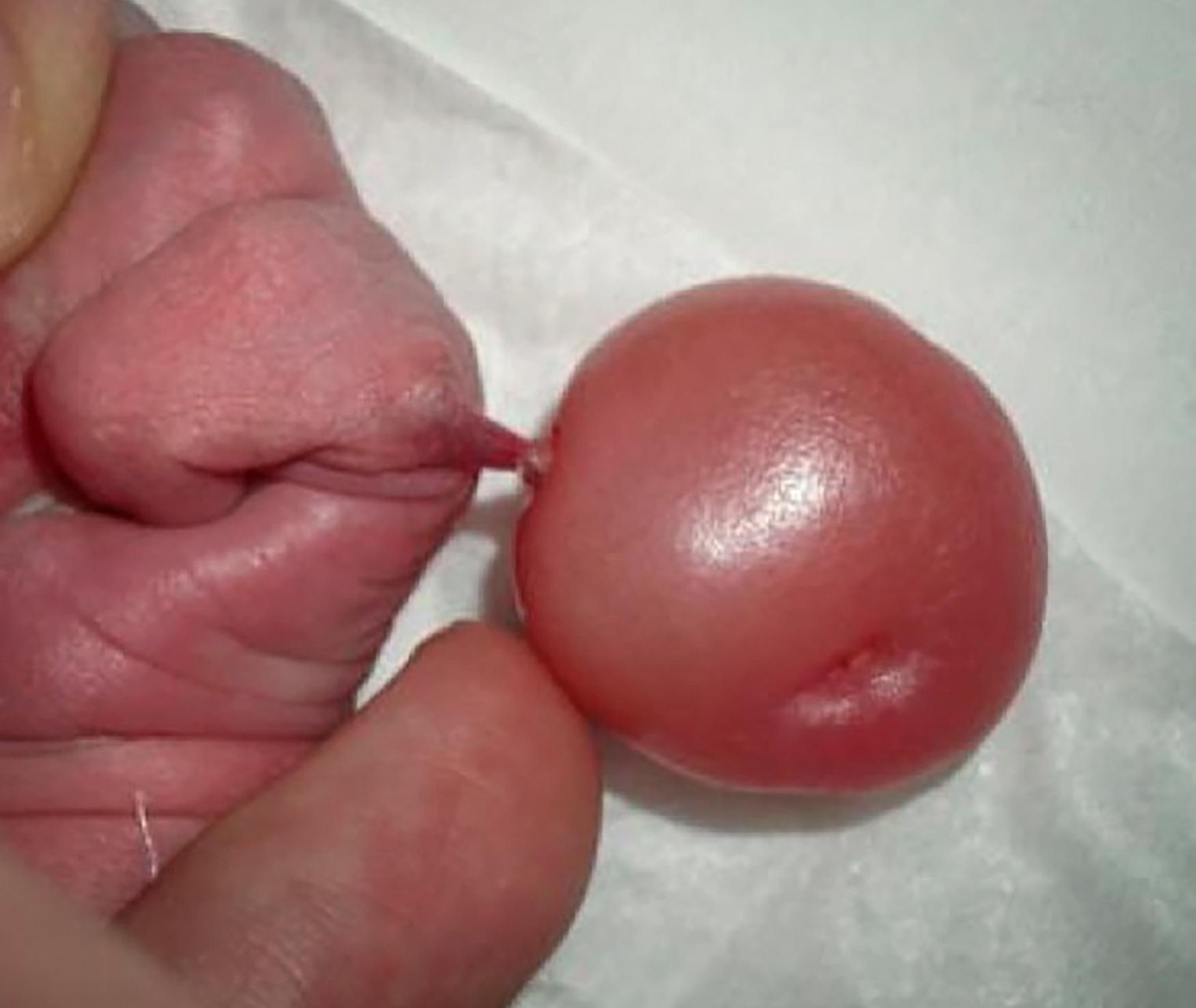
Type A forms, like a duplicated thumb, require operative digit ablation and small finger reconstruction, after the age of 18 months. After the extra digit is removed, any important functional parts (e.g., ulnar collateral ligament and abductor digiti quinti) are transferred to the adjacent finger (proximal phalanx base). An elliptic incision around the digit or a proximally based mirrored triangular flap is utilized and extended in a proximal direction to allow adequate exposure of the ligaments and muscles ( Fig. 36.34 ). A long-arm cast for 4 weeks is required following ligamentous reconstruction. Some complex type A forms exhibit stiffness of both digits and may be better treated with ray resections instead of reconstruction.
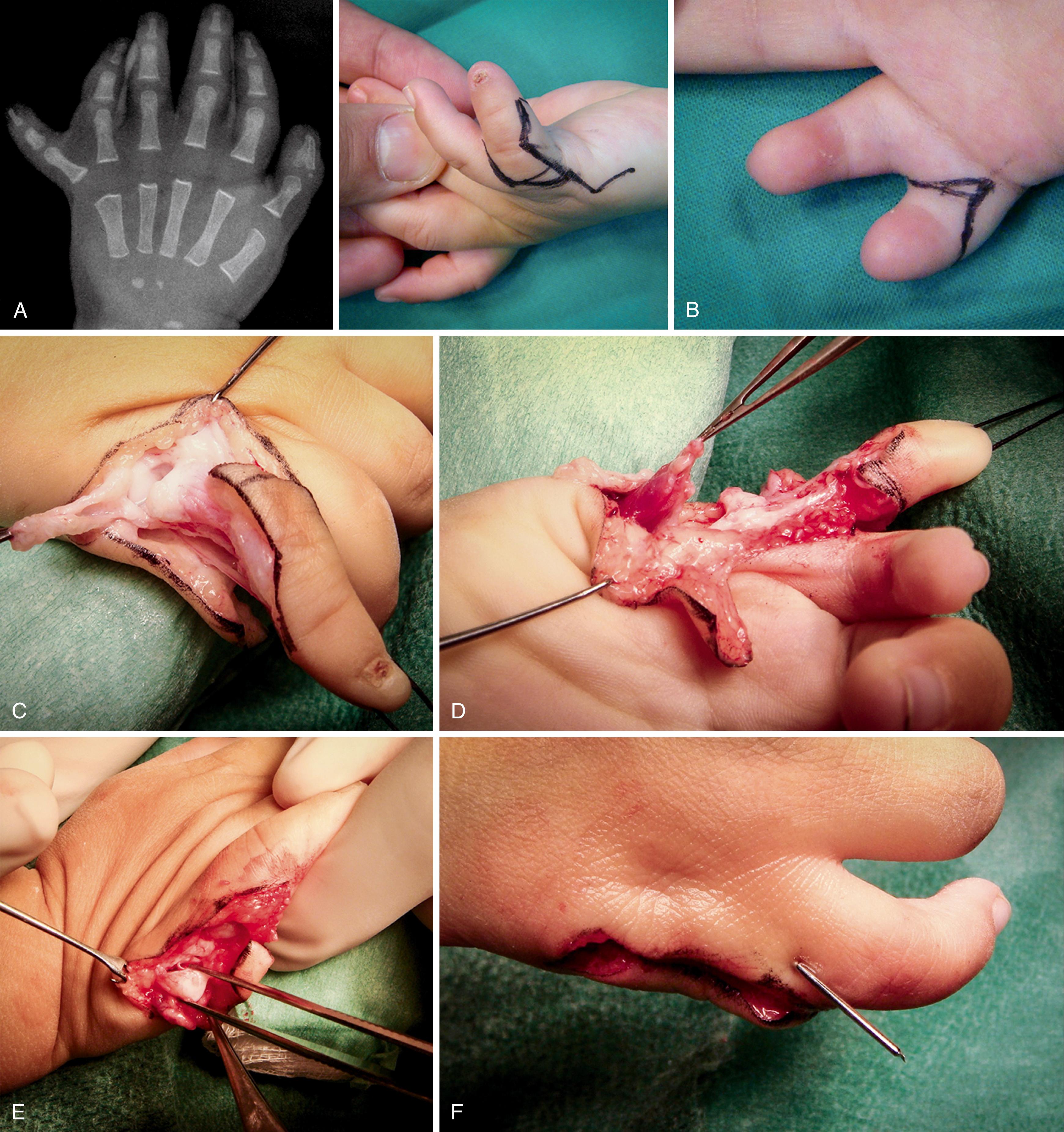
Type B elements are ablated in the office with the use of a bipolar electrocautery. The stalk is cauterized after injecting the base with local anesthesia combined with epinephrine ( ![]() ). This technique avoids the residual nubbin and can safely be performed in infants.
). This technique avoids the residual nubbin and can safely be performed in infants.
Large type B or type A forms require digit ablation and small finger reconstruction after the age of 18 months. When two digits sit on a single metacarpal head, a ligamentous-periosteal flap should be raised from the distal metacarpal-phalanx of the extra digit, and any extra- articular facet should be resected (see Fig. 36.34C to E). Additionally, in polydactyly at the level of MCP joint, the insertion of the abductor digiti minimi (ADM) should be carefully detached (see Fig. 36.34D ). The ligamentous-periosteal flap and detached ADM tendon is reattached to the base of the fifth proximal phalanx of the preserved digit. A Kirschner wire is inserted into the MCP joint when needed (see Fig. 36.34F ). Corrective osteotomy for angular deformity and/or rotational deformity of the small finger is performed if necessary. In young children, a long-arm cast is placed for 4 weeks and the Kirschner wire removed in the office.
Triplicated forms or duplicated at MCP joint level with rhombus shape are usually stiff and are better managed with amputation ( Fig. 36.35 ).
Ulnar polydactyly is frequently inherited in an autosomal dominant pattern but has a variable penetrance pattern. Ulnar polydactyly is more common in African Americans and radial polydactyly is more frequent in white individuals.
A small nubbin or rudimentary postaxial element can be safely removed with a bipolar electrocautery in the office.
Well-developed ulnar polydactyly requires operative reconstruction with transfer of any important parts (e.g., ulnar collateral ligament and abductor digiti quinti) to the retained finger.

Central polydactyly consists of a duplication within the hand involving the rays of the index, long, or ring finger. The ring finger is most commonly involved, followed by the long finger and index finger ( Fig. 36.36 ). The involved digit, as well as the adjacent digit, often demonstrate stiffness and abnormal deviation. Surgery attempts to improve function by addressing the stiffness and the deviation.
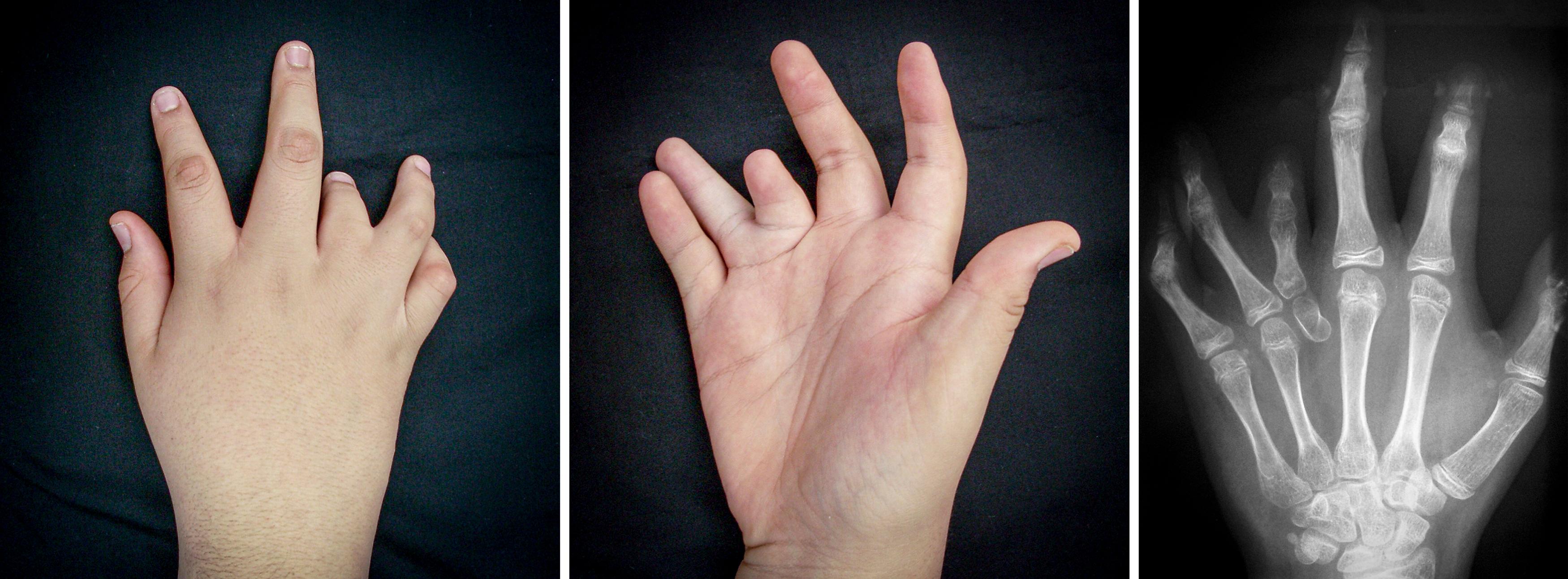
Prevalence and genetics vary according to geographic location. In the Western hemisphere, central polydactyly is 30% less frequent that ulnar polydactyly, and approximately 50% of patients demonstrate an autosomal dominant inheritance. In addition, 70% of the cases are bilateral. Conversely, Japanese reports indicate that central polydactyly is 30% more frequent than ulnar polydactyly and occurs without a family history.
Ring finger synpolydactyly uniformly has a familial inheritance pattern that is linked to a gene mutation (HOXD13 gene) on chromosome. Between 70% and 90% of central polydactylies are associated with syndactyly and can also be associated with cleft hand ( Figs. 36.37, 36.38, and 36.39 ). , The pathoanatomy of central polydactyly, syndactyly, and cleft hand are similar with each involving some degree of insult to the central apical ectodermal ridge (AER). As we discover more about embryology and genetics, some authors have proposed classifying them together as “abnormal induction of finger rays.” , In fact, bilateral cases can have all three deformities (central polydactyly, syndactyly, and cleft hand) in various combinations.
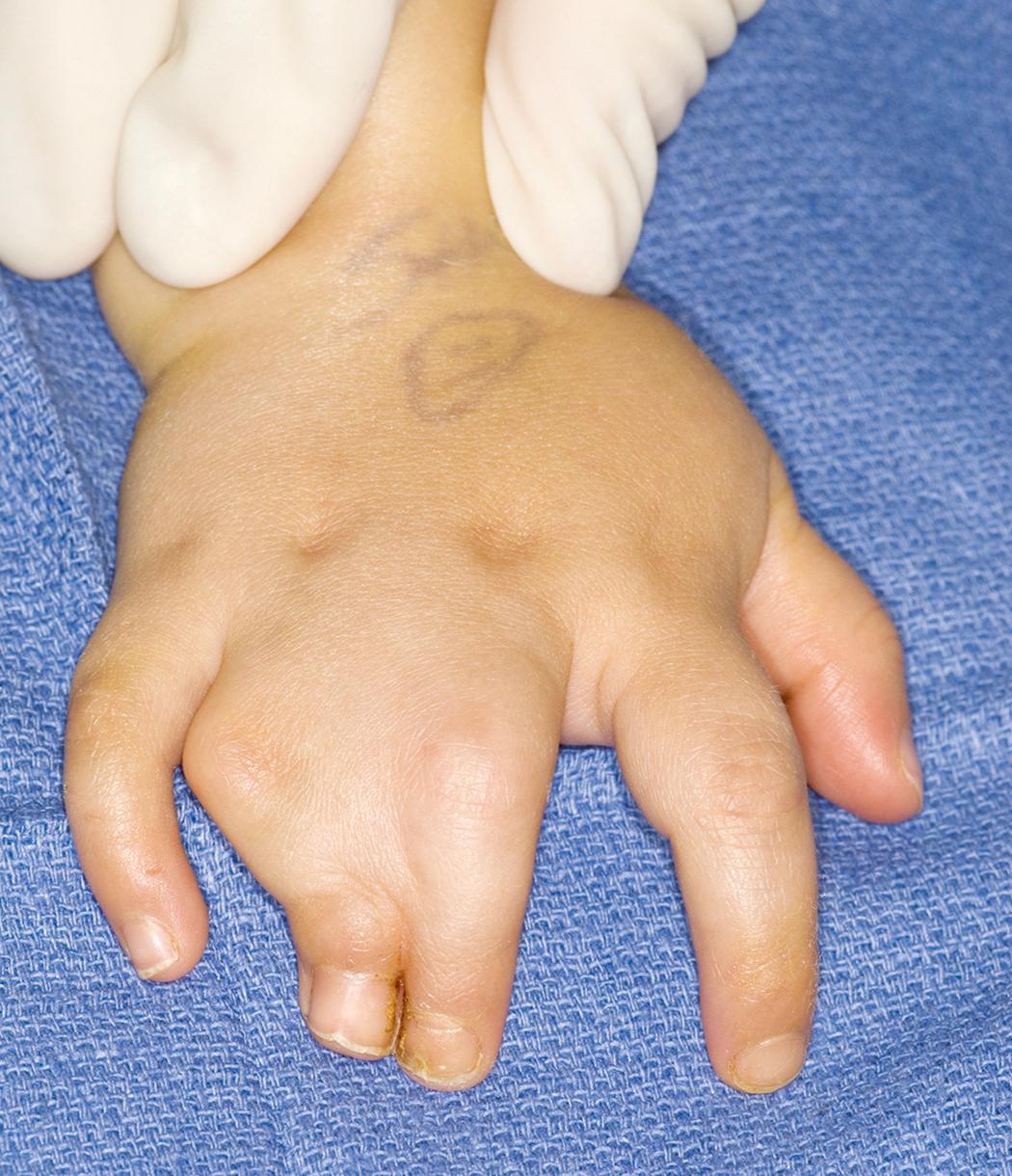
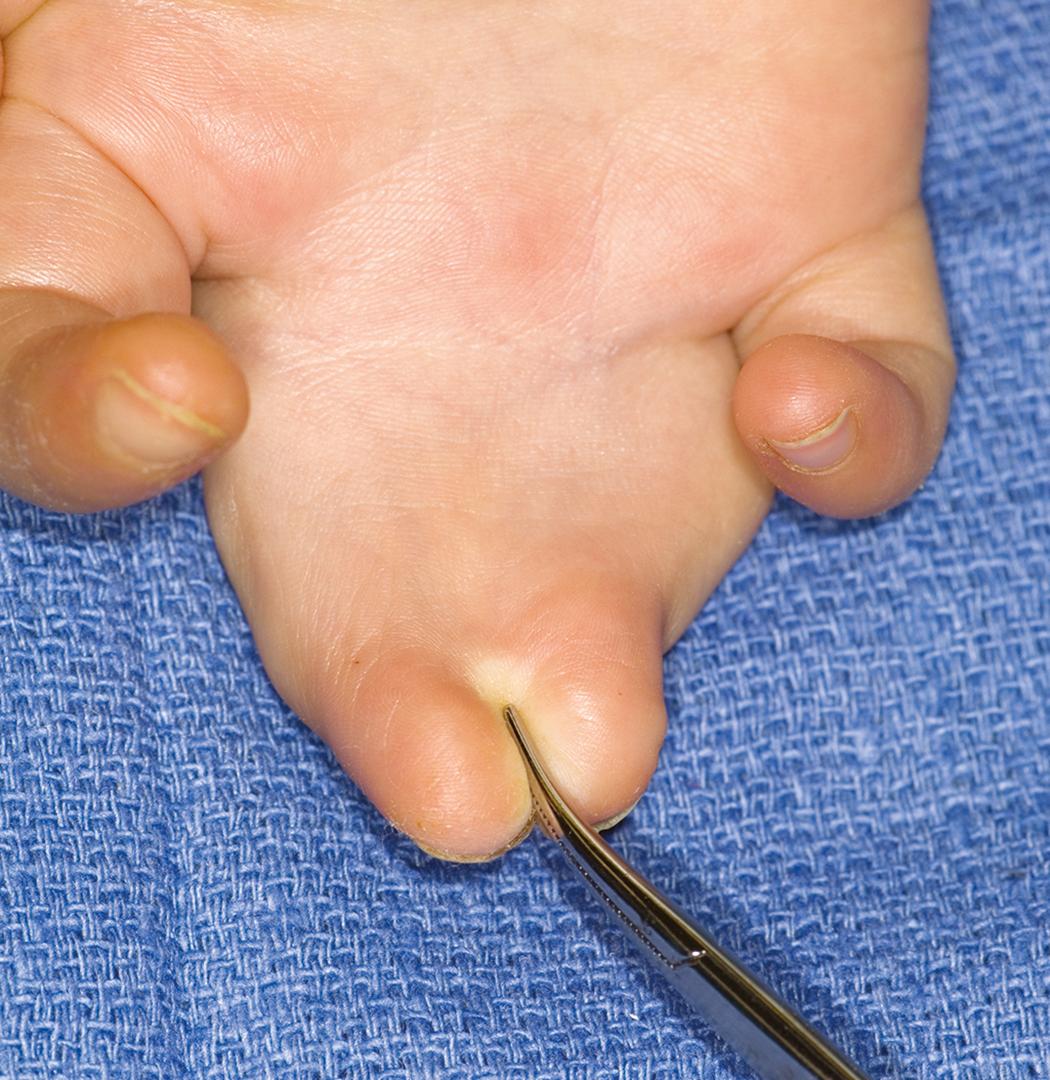
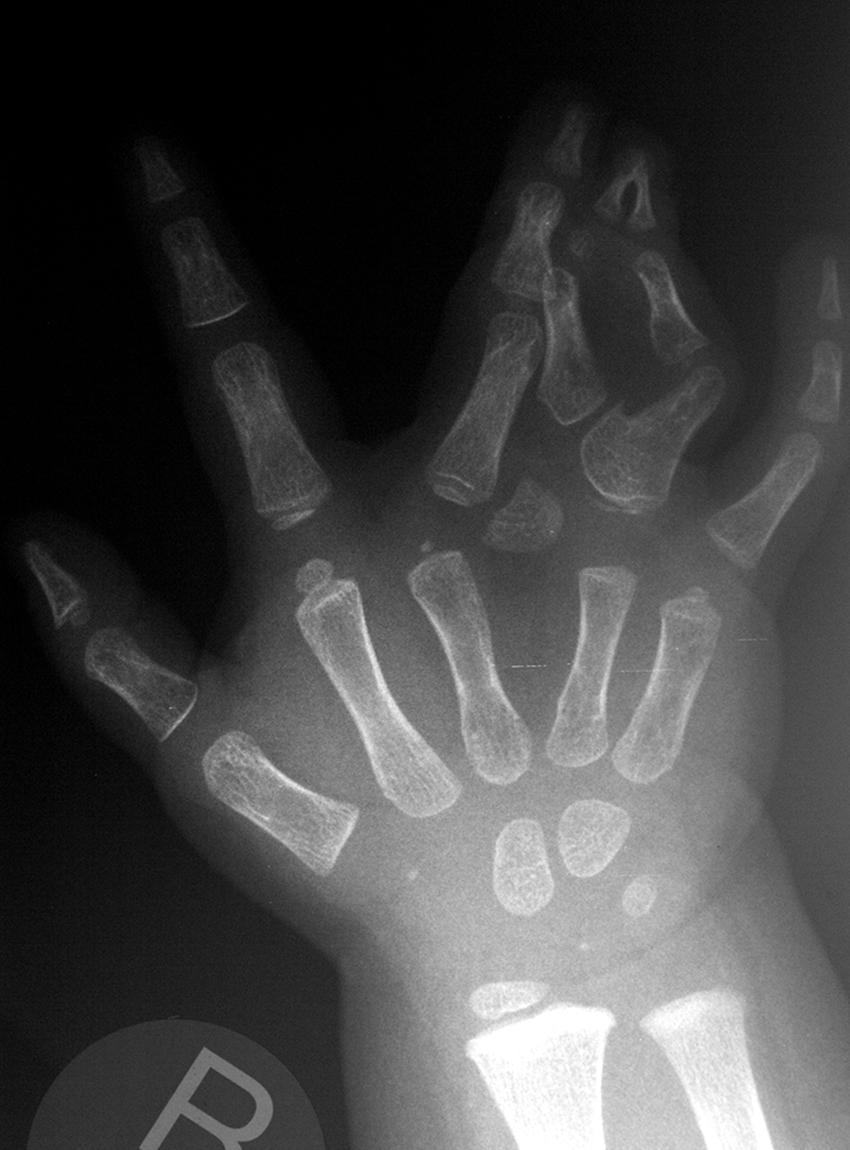
According to Stelling (1963) and Turek (1967) classifications, central polydactyly can be divided into three types. Type I: residual soft tissue digit ( Fig. 36.40 ); type II: incomplete osteoarticular structures (see Figs. 36.37 and 36.40 ); and type III: complete digit with its own metacarpal and all the soft tissues involved ( Fig. 36.41 ).

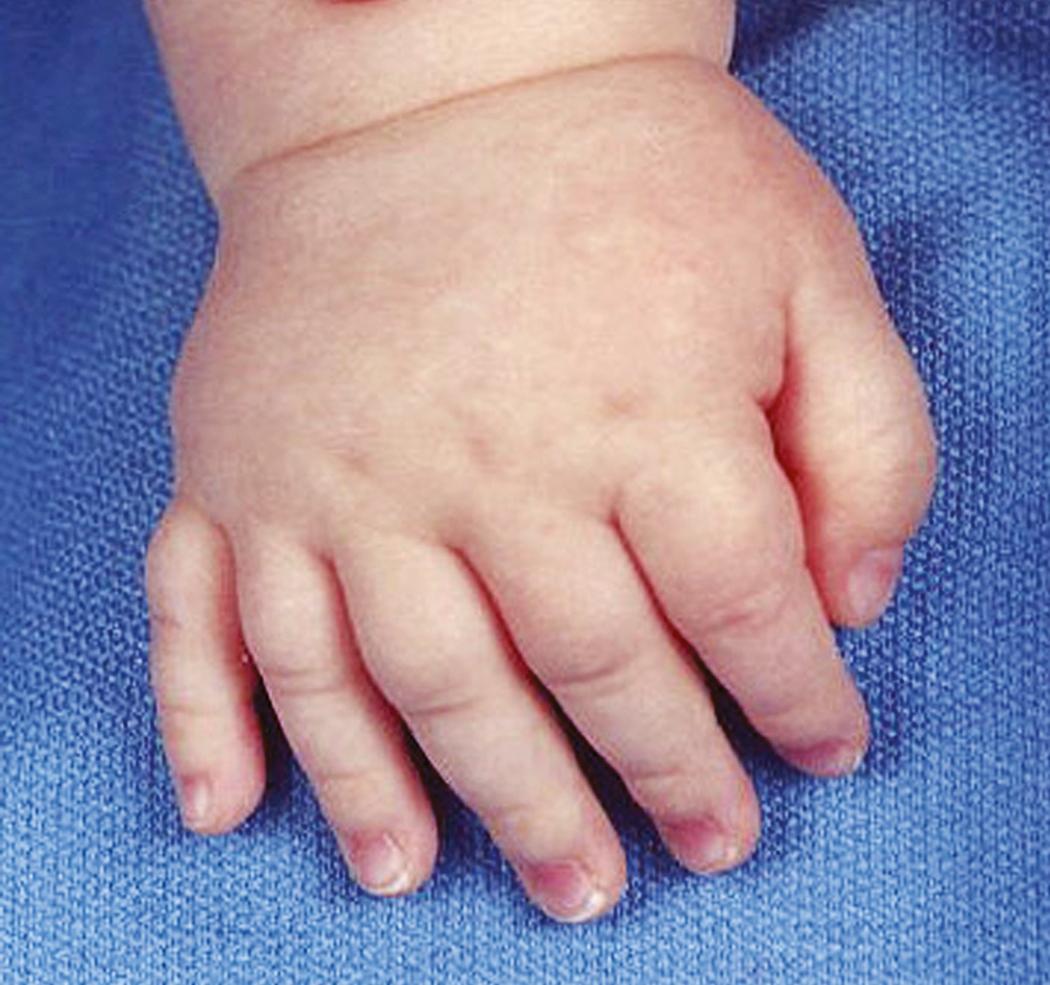
Type II, the most frequent type, can be subdivided in type IIB, or synpolydactyly with syndactyly (see Figs. 36.37, 36.38, and 36.39 ), or type IIA, synpolydactyly without syndactyly ( Figs. 36.40 and 36.42 ). Most type II cases have deviation and stiffness of the involved digit as well as the adjacent digit.
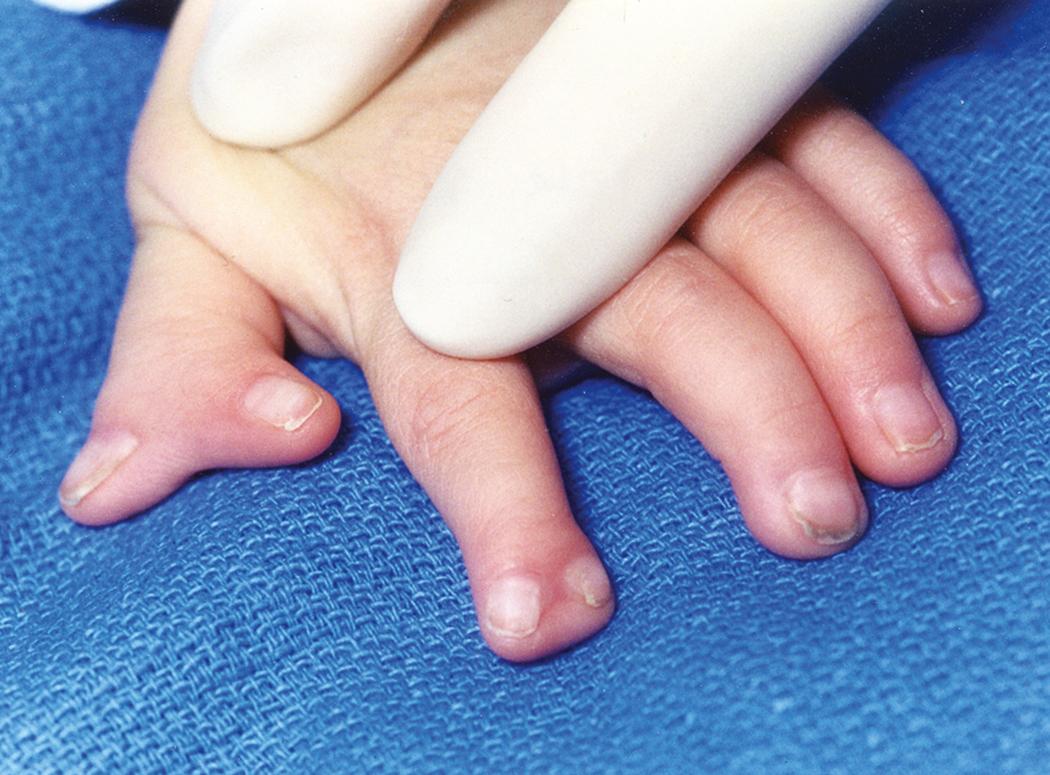
Type I and type III central polydactylies can be managed successfully with excision. For type III, ray amputation with reconstruction of web space and repair of transverse intermetacarpal ligament is performed. Concomitant corrective osteotomy may be required for persistent malalignment.
Type II polydactyly is difficult to treat. The affected and adjacent digits are often stiff at the MCP and IP joints. In addition, there can be a concealed angular or rotational deformity. Despite numerous well-intended surgeries, the ultimate results are poor with limited motion and persistent deviation. For complex type II central polydactyly, primary ray amputation may produce the best result. , The surgeon may also consider nonoperative treatment as central polydactyly with complex connections may be more functional without surgery.
Surgery is performed after the age of 18 months. Type I and type III are managed with nubbin excision and ray amputation, respectively.
Type II central polydactyly reconstruction is a challenging surgery, and a lengthy discussion is necessary to establish reasonable expectations. Nonoperative treatment or ray amputation are viable options in complex situations in which surgery would result in stiffness, malalignment, and additional esthetic problems. Surgical techniques are similar to syndactyly separation with a focus on commissure reconstruction, digital separation, and nail reconstruction. When intermetacarpal digit resection is required, the incisions may need to be extended in a proximal direction ( Figs. 36.43, 36.44, and 36.45 ). Corrective osteotomies involving the metacarpal or phalanx are performed as needed depending on the appearance of the digits after separation.
Central polydactyly is uncommon compared with border polydactyly in Western countries.
Central polydactyly hidden within a concomitant syndactyly (i.e., synpolydactyly) and is the most common form of presentation.
Synpolydactyly is difficult to treat. Separation of the syndactyly and reduction of the concealed polydactyly often result in stiffness and persistent angulation.
Central synpolydactyly with complicated connections may better be treated without surgery to avoid individual digits with limited motion, instability, and lack of function.
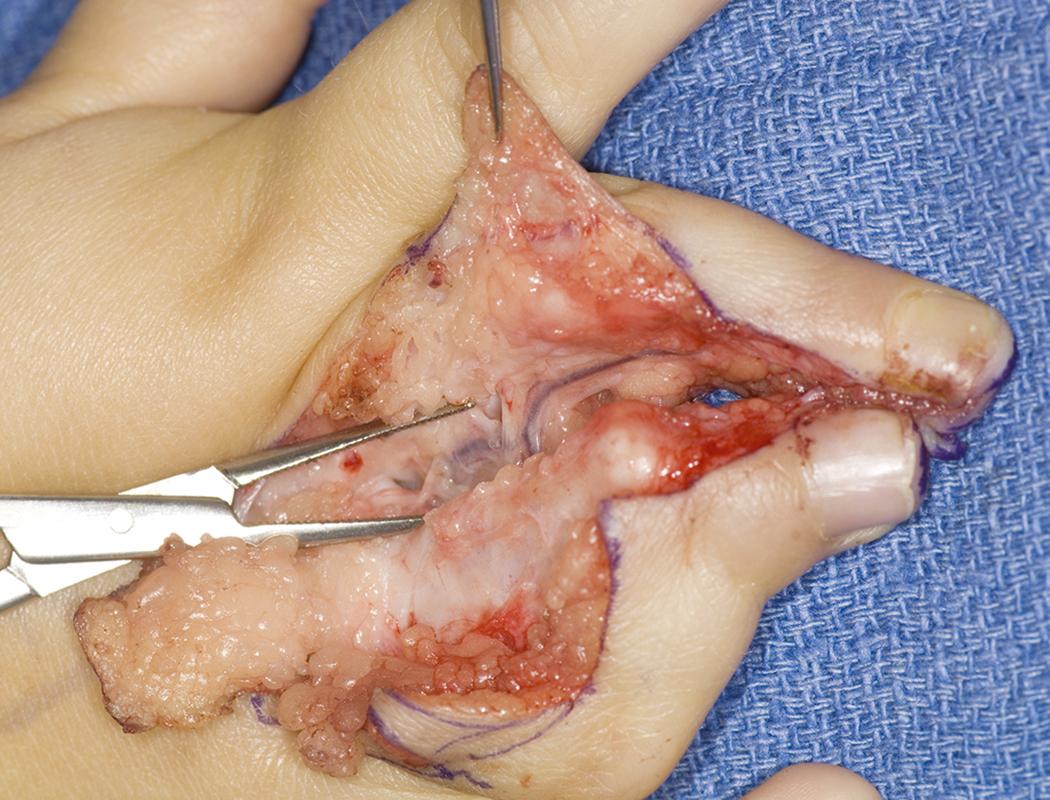
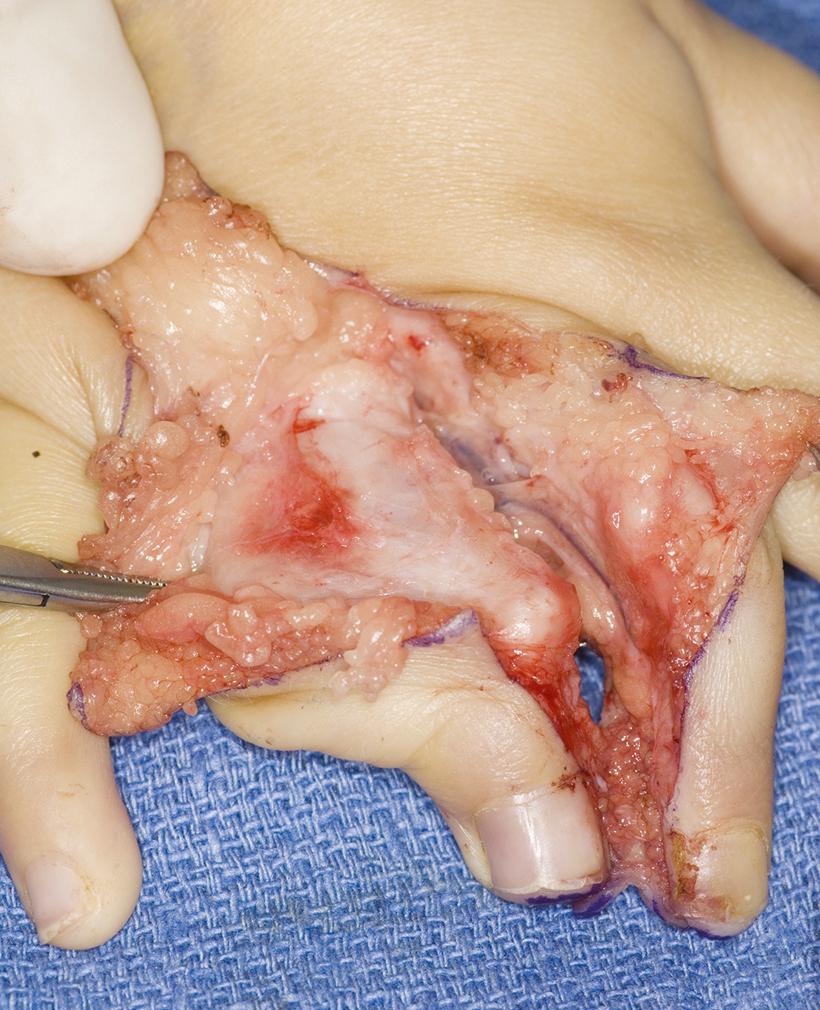
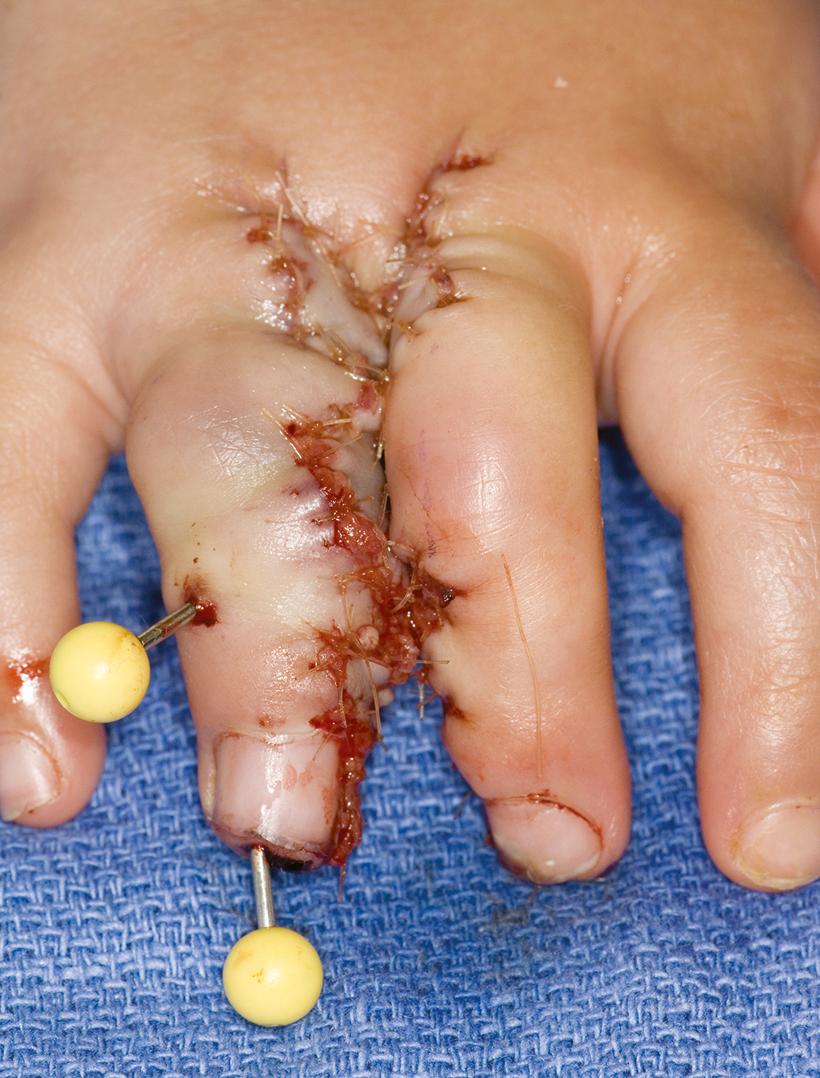
Mirror hand is a very rare congenital anomaly with less than 100 reported cases. , Mirror hand is characterized by a duplication of the postaxial hand, forearm, and elbow with an absence of preaxial structures (thumb, radius, and capitellum).
A symmetric duplication of the ulnar limb structures occurs in the midline. The typical mirror hand presents as a central digit (index) with three digits on each side that represent the middle, ring, and small digits in mirrored symmetry ( Fig. 36.46 ). Ulnar carpal elements are also duplicated. Within the forearm, there are two ulnas, and the distal humeral epiphysis is also abnormal ( Figs. 36.47 and 36.48 ). The duplicated ulna has led to the term “ulnar dimelia.”
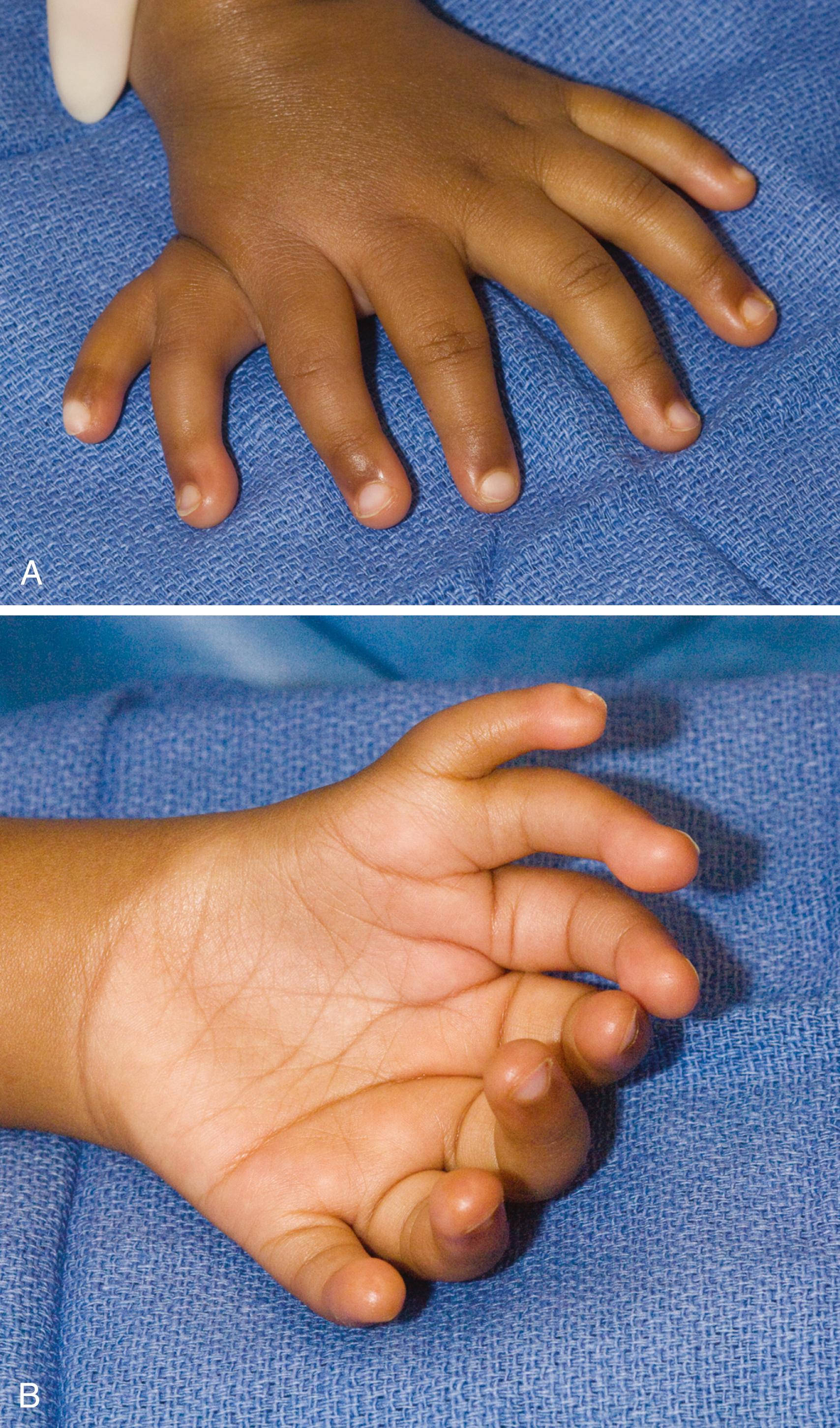
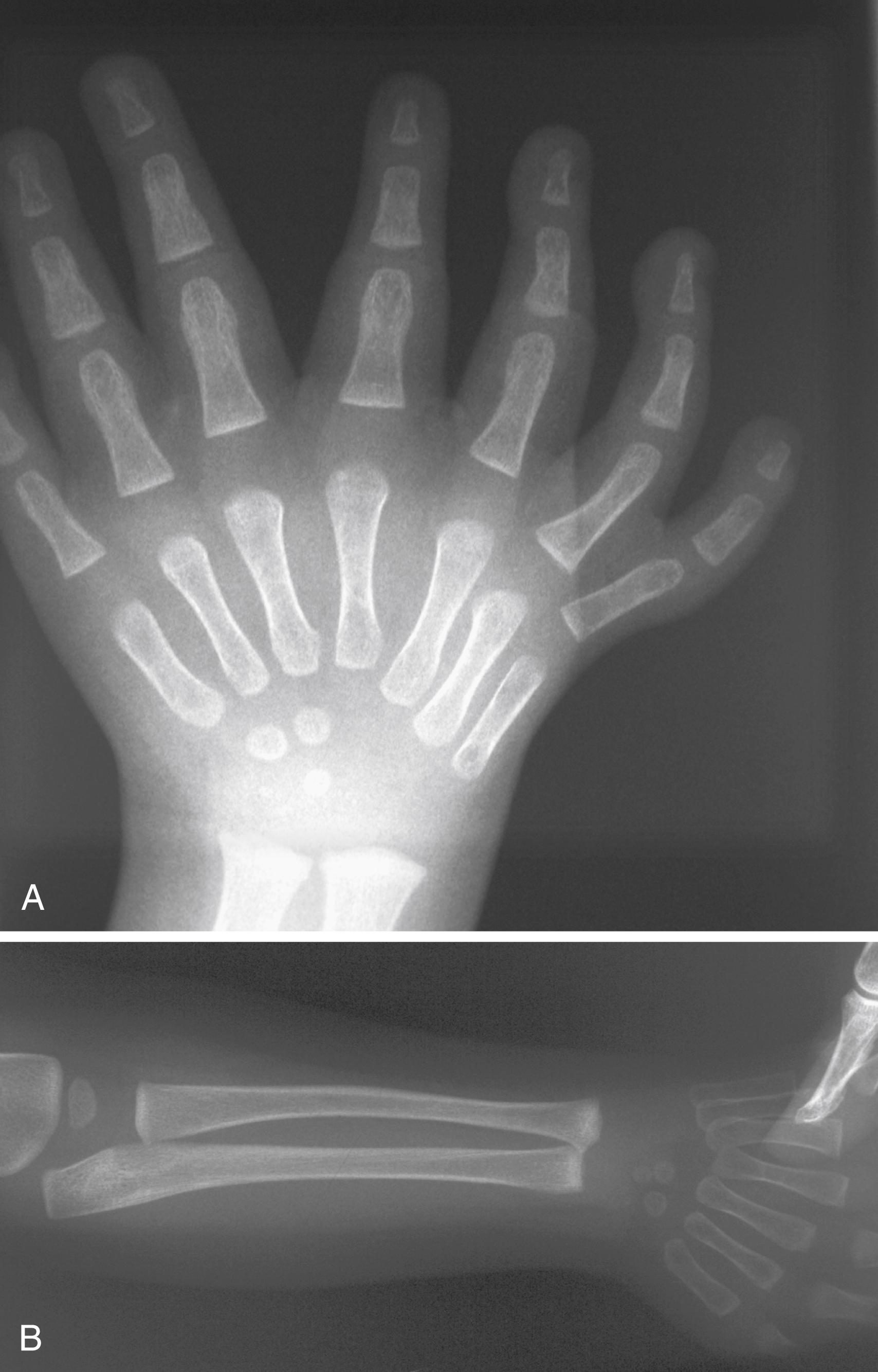
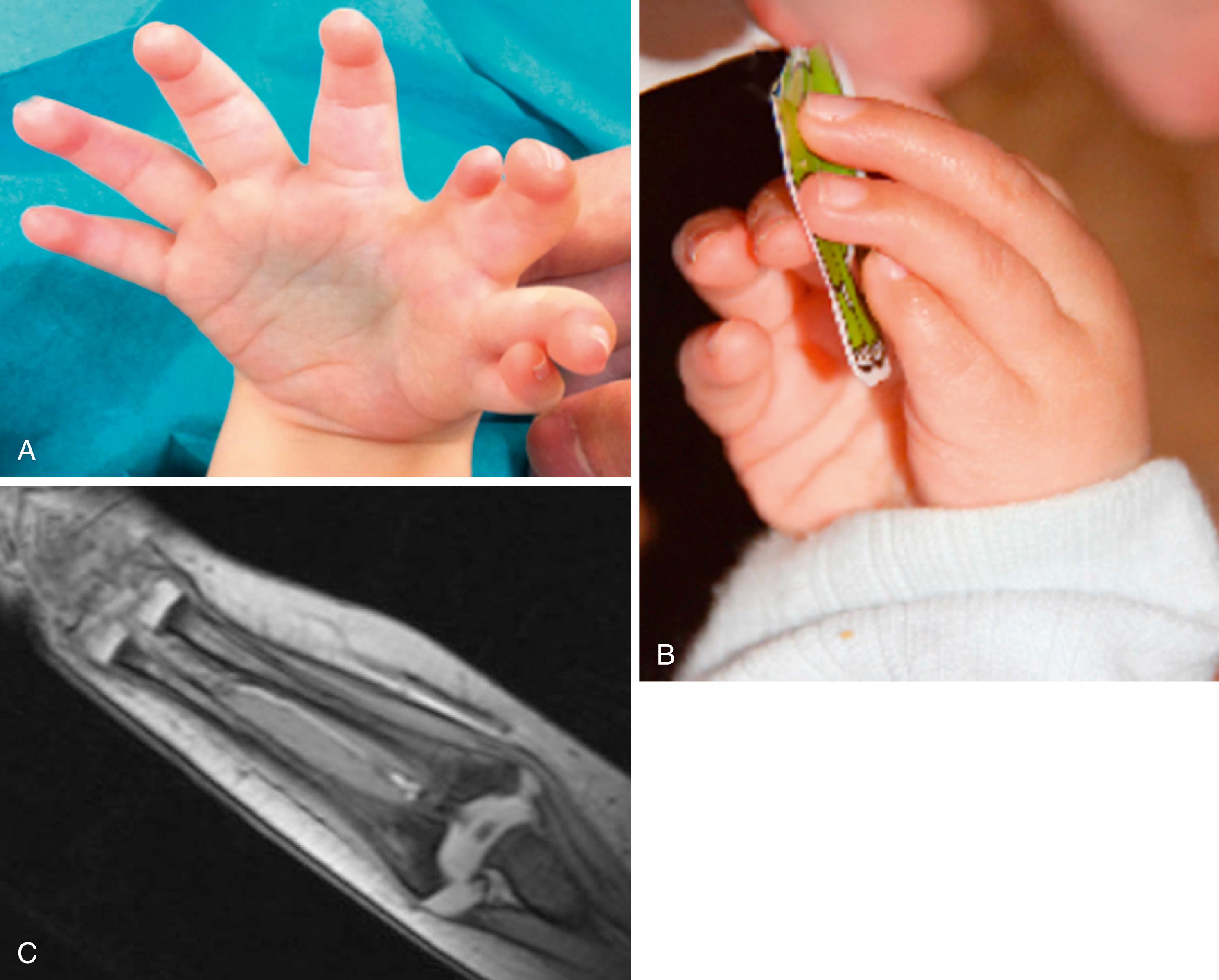
Abnormal anatomy of the wrist, forearm, and elbow results in a wrist flexion contracture, limited forearm rotation, and elbow extension contracture. Wrist flexion contracture is due to a volar carpal subluxation combined with hypoplastic wrist extensor muscles.
The clinical presentation varies according to the variable dysfunction of the zone of polarizing activity (ZPA) that governs radioulnar differentiation (see Chapter 35 , Embryology of the Upper Extremity).
Selective ablation of the supernumerary digits and thumb reconstruction are the mainstays of surgery. The procedure must reconstruct the first web space and augment the motor function of the preserved thumb by tendon transfers. The principles of pollicization with the use of “spare parts” are involved in reconstruction of the thumb ( Fig. 36.49 ). Pollicization of the most mobile radial digit and removal of the stiffer radial digits is performed ( Fig. 36.50 ). The skin from the ablated digits can be used to augment the first web space ( Fig. 36.51 ).

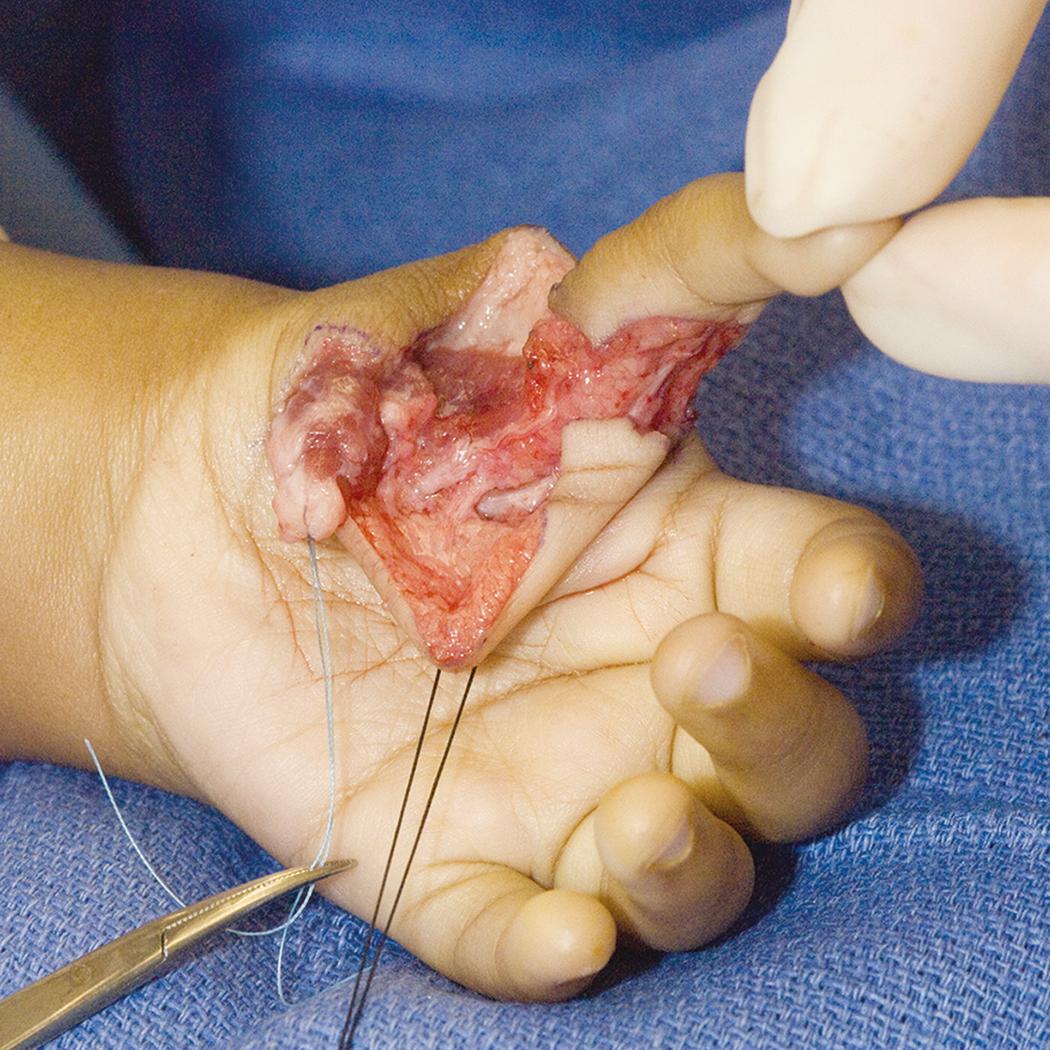

Reported results regarding wrist and elbow reconstruction are disappointing. Carpal wedge osteotomy combined with flexor digitorum superficialis tendon transfer from the ablated digits to the dorsum of the wrist may augment wrist extension. Resection of the proximal ulna on the radial side may increase elbow flexion, although our results have been inconsistent.
Mirror hand is rare and characterized by symmetric duplication of the limb in the midline. Typically, there is a central digit with three digits on each side and absence of the thumb.
The forearm often has two ulnae and no radius with a stiff wrist and elbow.
The etiology has been attributed to transplantation or replication of the zone of polarizing activity from the posterior margin of the limb bud to the anterior region.
Treatment consists of reduction of the number of digits to four and reconstruction of a thumb from the deleted digits.
Brachydactyly (“short digits”) refers to disproportionately short fingers and toes.
Two clinical situations of brachydactyly should be considered: isolated brachydactyly ( Table 36.2 ) and syndromic brachydactyly ( Table 36.3 ). Numerous rare diseases have a component of brachydactyly. The Online Mendelian Inheritance in Man website ( www.OMIM.org ) is a useful diagnostic tool when a patient with brachydactyly is evaluated. This tool can help decipher most clinical entities and provides a phenotype Mendelian Inheritance in Man (MIM) number and a gene locus MIM number (identified causative gene defect).
| Generalized brachydactyly | Achondroplasia Hypochondroplasia Diastrophic dwarfism Mucopolysaccharidosis Multiple epiphyseal dysplasia Spondyloepiphyseal dysplasia Metaphyseal dysostosis Peripheral dysostosis Dyschondrosteosis Hereditary multiple exostosis Ollier disease Weill-Marchesani syndrome Ellis–van Creveld syndrome Orofaciodigital syndrome |
| Underdevelopment of distal phalanges | Pycnodysostosis Cleidocranial dysostosis Fanconi anemia Progeria Larsen syndrome Keutel syndrome Pudiger syndrome Coffin-Siris syndrome |
| A3 brachydactyly (short middle phalanx of little finger) | Down syndrome Poly X syndrome Russell-Silver syndrome Coffin-Siris syndrome Orofaciodigital syndrome (types I and II) Otopalatodigital syndrome Thrombocytopenia–absent radius syndrome Noonan syndrome |
| D brachydactyly (stub thumb brachydactyly) | Tabatznik syndrome Rubinstein-Taybi syndrome Robinow syndrome |
| Brachydactyly with metacarpal shortening | Turner syndrome Albright hereditary osteodystrophy Pseudohypoparathyroidism Pseudopseudohypoparathyroidism |
| Brachydactyly with short first metacarpal | Holt-Oram syndrome Fanconi anemia Progressive myositis ossificans Otopalatodigital syndrome Diastrophic dwarfism |
| Brachydactyly with polydactyly | Ellis–van Creveld syndrome Orofaciodigital syndrome |
| Brachydactyly with syndactyly | Cornelia de Lange syndrome Apert syndrome |
| Brachydactyly with cone-shaped epiphyses | Trichorhinophalangeal syndrome Langer-Giedion syndrome Acrodysostosis |
| Miscellaneous | Du Pan syndrome Hand-foot-uterus syndrome |
| Type A | A1: Farabee brachydactyly | Principal feature: Short middle phalanges (sometimes fused to distal phalanges). Associated feature: short proximal phalanges of thumbs and great toes. |
| A2: Mohr-Wriedt brachydactyly (Mohr, 1919) | Principal feature: Short delta phalanx deformity of middle phalanges, index fingers, and second toes. | |
| A3: Bauer brachydactyly–clinodactyly (brachymesophalangy V) | Principal feature: Short rhomboid or delta middle phalanx of the small finger. | |
| A4: Temtamy brachydactyly (Temtamy, 1978) | Principal feature: Short middle phalanges of index and small fingers. Associated features: Ring finger middle phalanx short, middle phalanges of toes short, and talipes calcaneovalgus. |
|
| A5: Bass brachydactyly (Bass, 1968) | Principal feature: Absent middle phalanges, hypoplastic nails in fingers and toes. Associated feature: Hypoplastic distal phalanges. |
|
| Type B | Mackinder brachydactyly | Principal feature: Hypoplastic distal phalanges with absent nails. Associated features: Thumbs and great toes may be normal or duplication of distal phalanges may occur; symphalangism. Syndactyly. |
| Type C | Drinkwater brachydactyly (Drinkwater, 1916) | Principal feature: Short middle phalanx of index and middle fingers. Short delta middle phalanx of small finger. Hyperphalangism of index and middle fingers, with ulnar deviation of these digits. Associated features: Short metacarpals. Symphalangism. |
| Type D | Breitenbecher brachydactyly (stub thumb) | Principal feature: Short distal phalanx of thumb. |
| Type E | Bell brachydactyly (brachymetacarpia/brachymetatarsia) (Bell, 1951) Subclassified by Hertzog |
Principal feature: Short metacarpals and metatarsals with phalanges of normal length. Associated features: Short stature. Joint laxity. |
| Type E1 | Short fourth metacarpals and metatarsals. | |
| Type E2 | Variable combinations of short metacarpals and phalanges. | |
| Type E3 | Variable combinations of short metacarpals and normal phalanges. | |
| Other types | Pitt-Williams brachydactyly (Pitt, 1985) | Short distal phalanges of ulnar digits, short metacarpals, and normal stature. |
| Sugarman brachydactyly (Sugarman, 1974) | Short proximal phalanges with symphalangism. | |
| Smorgasbord brachydactyly | Combination of types A2 and D brachydactyly. |
In isolated brachydactyly, the inheritance is most commonly autosomal dominant with variable expressivity and penetrance ( Fig. 36.52 ). The various types of isolated brachydactyly are rare, except for type AIII (classical clinodactyly; OMIM: 112700 ) and type D (the classic stub thumb; OMIM: 113200 ) ( Fig. 36.53 ), which have a prevalence of approximately 2%.

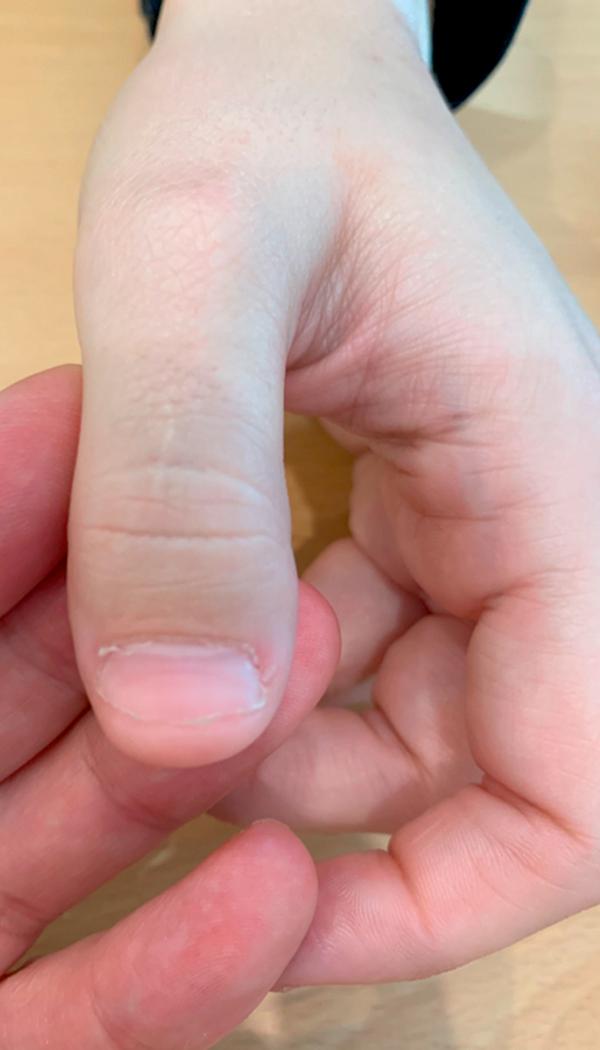
The pattern of involved bones and digits is highly consistent for each isolated or syndromic brachydactyly. The most commonly involved bones are the middle phalanx (brachymesophalangy) followed by the metacarpal (brachymetacarpy). Distal (brachytelephalangy) and proximal phalanxes (brachybasophalangy) are less commonly involved. Bone anomalies often include triangular-shaped epiphyses of the proximal phalanx (longitudinal epiphyseal bracket) of the small finger that can lead to an angular deformity ( Fig. 36.54 ).
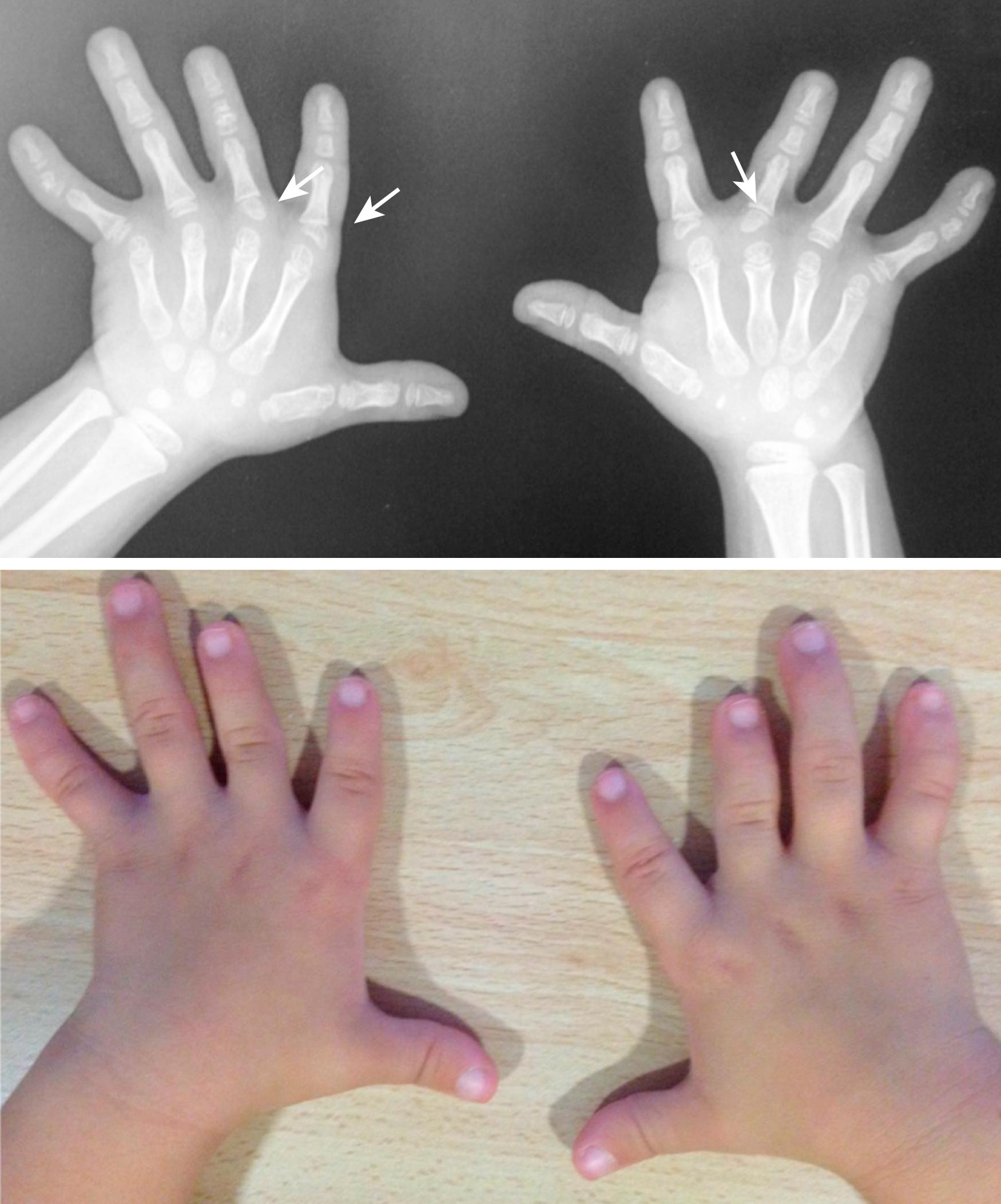
The most commonly used classification of isolated brachydactyly is by Bell and elaborated by Temtamy and McKusick (see Table 36.2 ). , This classification system is based on the anatomy of the brachydactyly. Another classification system proposed by Kellam (1974) focuses on the syndromic component of brachydactyly (see Table 36.3 ).
Noteworthy syndromes associated with brachydactyly include the following:
Pseudohypoparathyroidism involves the metacarpals of the ring and small and sometimes the long fingers ( Fig. 36.55 ). The loss of metacarpal prominence results in a shortened MCP joint.
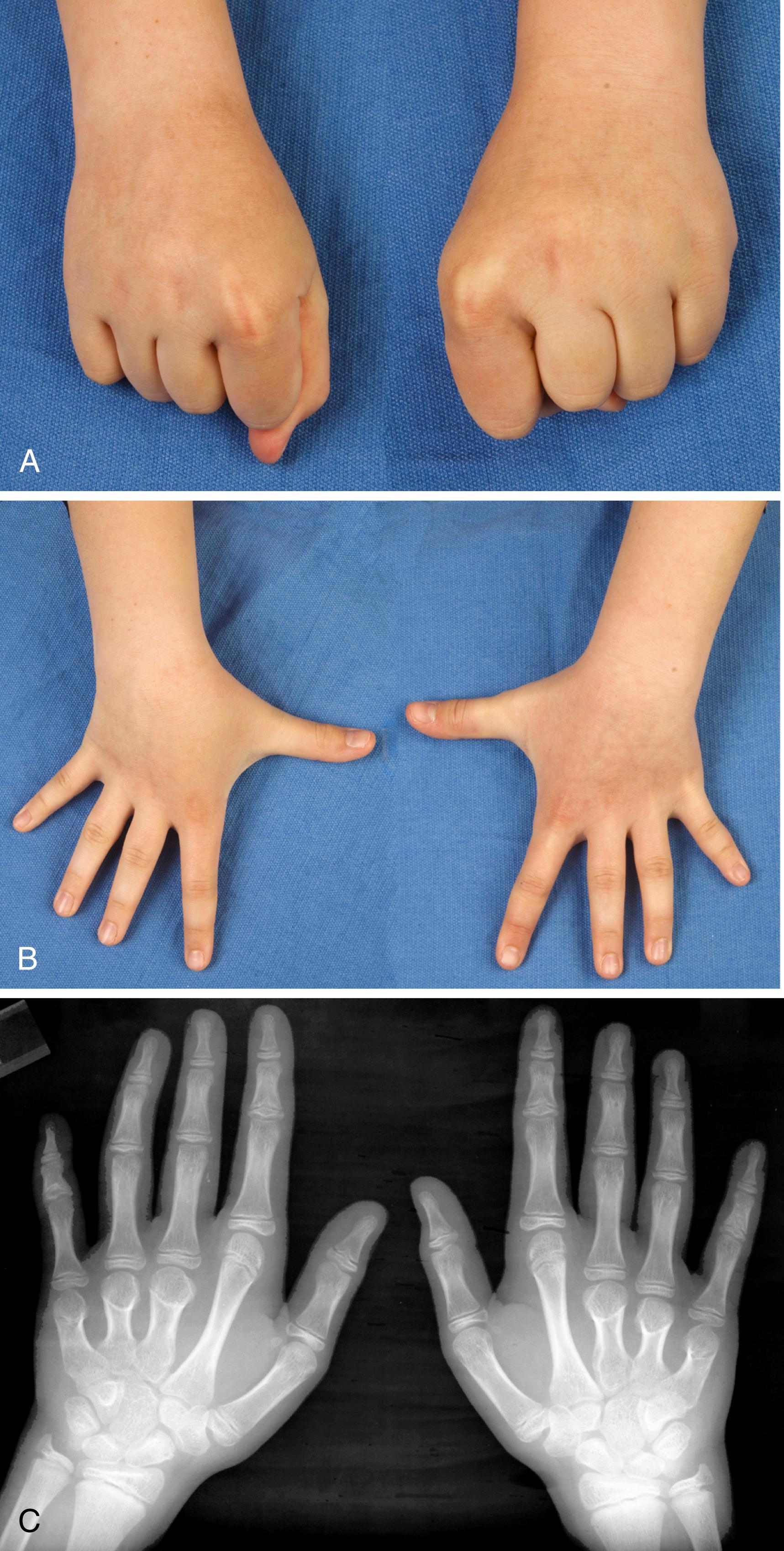
Grebe chondrodysplasia is a severe brachydactyly involving both hands and feet. All digits are affected, and there is absent MCP and metatarsophalangeal (MTP) joints ( Fig. 36.56 ).

Rubinstein-Taybi syndrome typically has a thumb with features of clinodactyly and brachydactyly ( Fig. 36.57 ).
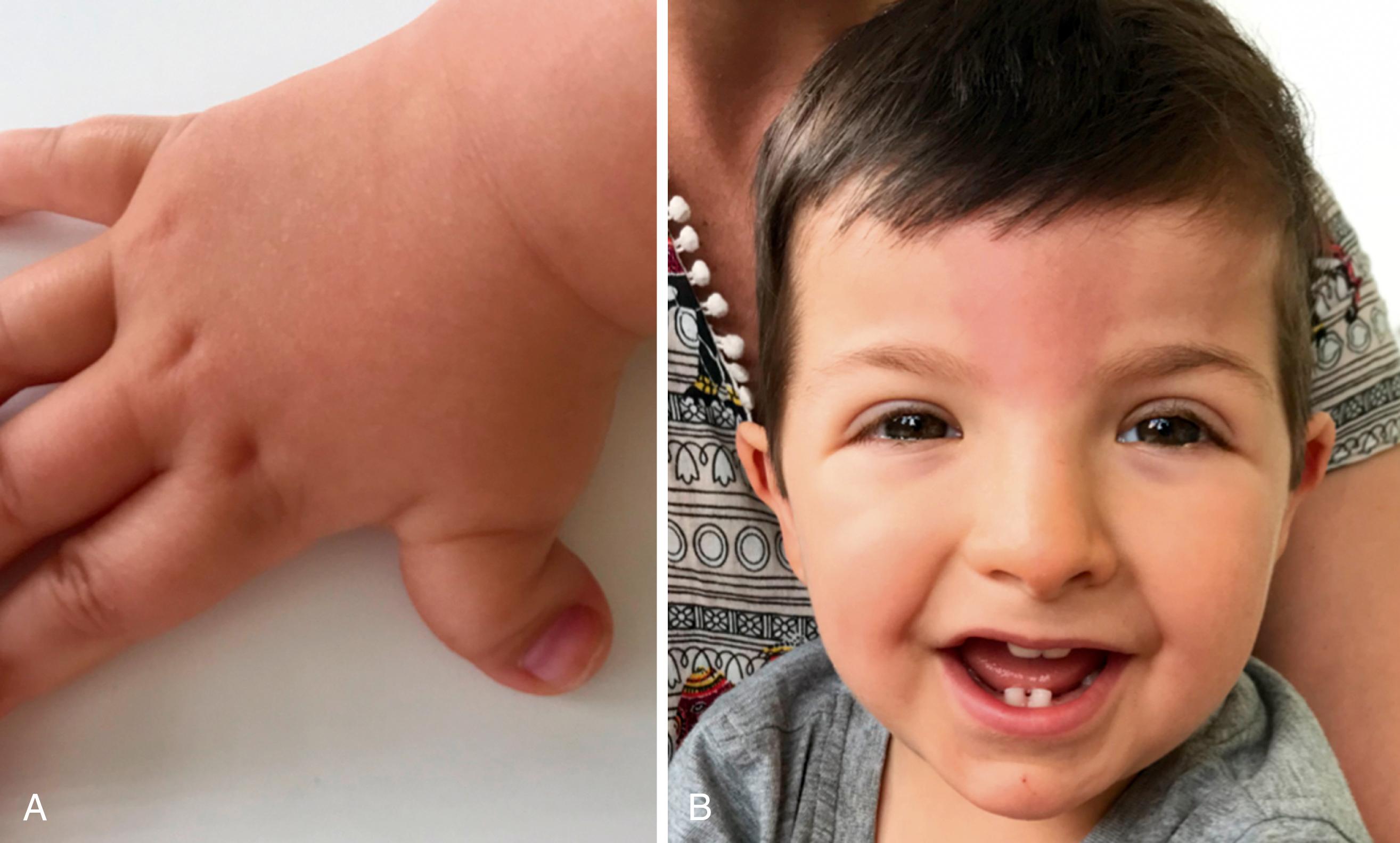
The vast majority of patients have no functional problems, and digital lengthening is not indicated owing to the risk of stiffness and loss of function. Angular malalignment correction is indicated when crossing or scissoring is present. Closing wedge or opening wedge osteotomies are options.
Many patients, or families of patients with brachymetacarpy, request metacarpal lengthening of the shortened rays. We discourage lengthening as the risks outweigh the benefits. Most described lengthening techniques utilize a dorsal approach, which results in unsightly scar. A palmar approach for lengthening of short central metacarpals has also been described.
Most authors who are proponents of lengthening utilize lengthening distraction osteogenesis with an external fixator. Distraction osteogenesis allows for substantial lengthening and avoids bone grafting. However, risks of external fixation include pin infection and loosening. Distraction rate varies from 0.5 to 1 mm/day. , Even in older patients, a distraction rate of 1 mm/day typically results in healing. The need for additional grafting after distraction is rare in patients younger than 18 years of age, even with lengthening of >30 mm.
Dhalla and colleagues described a technique applicable to small bones with only one pin on each side of the osteotomy, supplemented with an intramedullary Kirschner wire to maintain alignment.
Single-stage lengthening has also been described. Immediate lengthening of the metacarpal may require soft tissue reconstruction as the transverse metacarpal ligaments may need to be divided and the origins of the interosseous muscles may require advancement ( Fig. 36.58 ). Intercalary bone graft is usually required. Fixation can be accomplished with external fixation, Kirschner wires, or internal fixation. Disadvantages of one stage technique included the limited lengthening capacity (10 to 15 mm) and the need for bone graft.

Lengthening of shortened phalanxes is rarely indicated. Phalanx angular deformities are corrected with a closing wedge osteotomy stabilized with a Kirschner wire. The Kirschner wire is drilled retrograde from the fingertip crossing the IP joint and residing just proximal to the level of the proposed osteotomy. A midaxial approach is performed at the osteotomy site. The periosteum is elevated and a small rongeur used to remove a wedge of bone preserving the contralateral cortex. Next, the wedge is firmly closed by creating a greenstick deformity or cracking the intact cortex. The Kirschner wire is drilled across the osteotomy. The wound is closed, and the hand immobilized in a cast covering the Kirschner wire. The cast and Kirschner wire are removed at 4 weeks after surgery in the office.
Physicians considering lengthening a shortened metacarpal must have a thorough discussion regarding the risks and benefits of the procedure. In the rare case of metacarpal lengthening, we use a dorsal uniplanar distractor with two pins on each side of the osteotomy. All pins must be perpendicular to the longitudinal axis of the bone. A subperiosteal osteotomy is performed between the pin carriages. A Kirschner wire is used to perforate the cortices and an osteotome used to complete osteotomy. Distraction begins 4 and 7 days after surgery at a rate of 1 mm/day. Our preference is 0.25 mm lengthening four times a day. The external fixator is not removed until consolidation of the metacarpal is evident on radiographs. Supervision by a hand therapist is required to prevent stiffness during the lengthening process. Regular radiographs are essential to assess the progress of the distraction. The rate of distraction can be adjusted to the amount of bone forming across the osteotomy site. Radiographs are also assessed for pin displacement, pin site lucency, and failure of the apparatus.
Brachydactyly refers to shortening of the digit or ray within the hand. Brachydactyly can occur sporadically or as part of a syndrome.
The functional and esthetic impact of brachydactyly varies according to the extent of shortening, the number of digits involved, and associated anomalies such as syndactyly, clinodactyly, or symphalangism.
The most commonly affected bone is the middle phalanx.
Short bones may be lengthened, although the risks and benefits of the surgery must be carefully considered. There needs to be some functional benefit to consider lengthening.
The potential complications of lengthening are related to the soft tissues. Joint contracture or stiffness can develop in the lengthened digit and even the adjacent normal digits. Enthusiasm for lengthening, particularly of the markedly shortened digit, must be tempered by these considerations.
Central deficiency of the hand represents a broad group of deformities primarily affecting the central rays of the hand. Historically, central deficiency was subdivided into typical and atypical types on the basis of clinical features, but the atypical cleft hand is now recognized as symbrachydactyly and considered a transverse rather than a longitudinal deficiency. This section will focus on central hand deficiency or the typical cleft hand. The hallmark of central hand deficiency is characterized by a “V”-shaped cleft in the center of the hand, which may or may not be associated with the absence of one or more digits ( Fig. 36.59 ). Clinically there is a spectrum of soft tissue and skeletal deficiency that Maisels, building on the observations of Walker and Clodius, proposed progressed in severity from a central soft tissue defect to complete absence of all digits with a centripetal suppression of digits in a radial direction from the central cleft so that in the monodactylous form, the most ulnar finger is preserved. , This orderly progression of the phenotype of this condition is complicated by the commonly associated findings of syndactyly, central polydactyly, and skeletal deformity with additional cross-bones between the residual digital rays ( Fig. 36.60 ). These clinical observations, in combination with the experimental observations of animal models of teratogenicity, led to the proposal that cleft hand is related to a failure of induction of the central digital rays, rather than being a longitudinal deficiency as it was originally classified by Swanson. In light of advances in limb bud development and the pathogenesis of central deficiency attributed to a defect in the central portion of the AER, central deficiency is classified as a malformation of the hand plate in the proximo-distal axis in the Oberg, Manske, and Tonkin (OMT) classification. ,
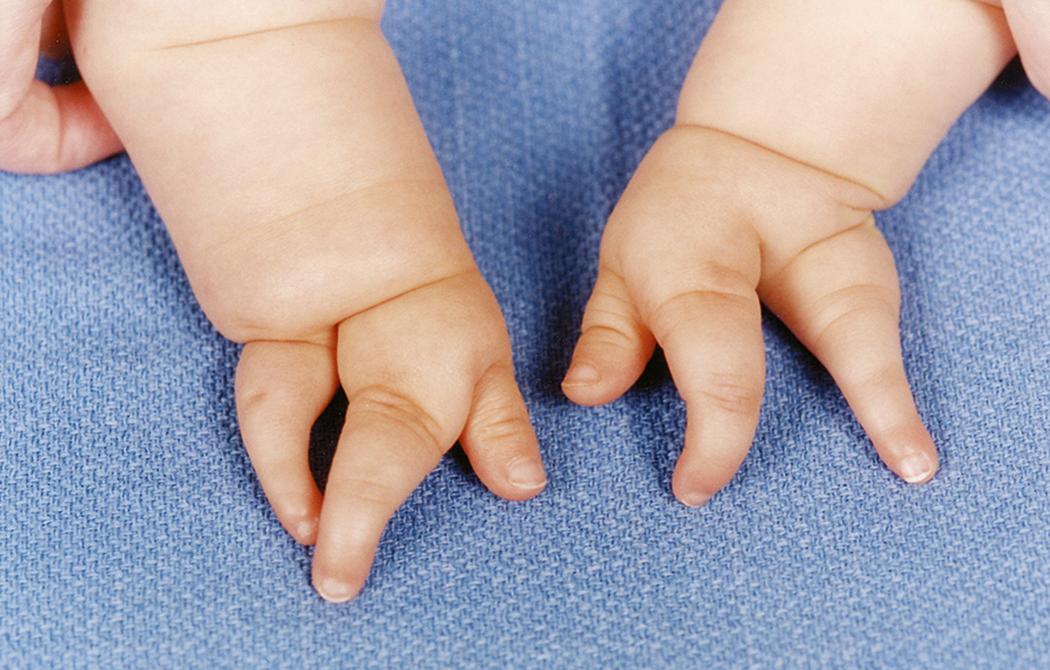
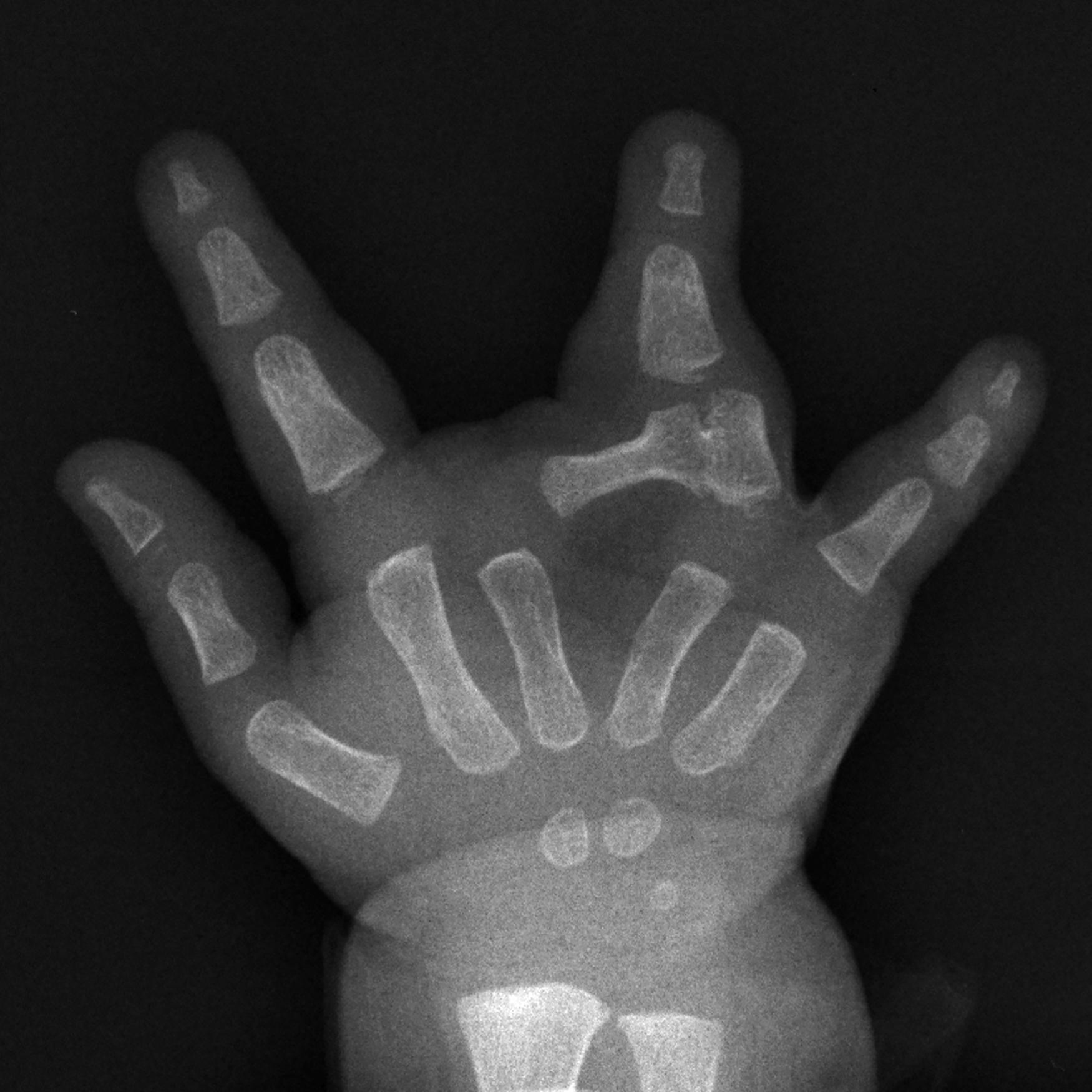
The etiology of the cleft hand anomaly has been deduced from animal models, particularly the dactylaplasia mouse that has specific Dac gene mutations in two loci on chromosome 19 and expresses a cleft phenotype in its heterozygote form. In this model, the central segment of the AER undergoes cell death in the early stages of limb bud development with consequent failure of central digit development. This theory of etiology has been corroborated by Ogino and colleagues, who have produced rats with cleft hand/foot deformity, central polydactyly, and/or osseous syndactyly with exposure to the teratogen busulfan. , Fetal studies in this model have identified a combined ectodermal and mesodermal injury in the developing limb bud with disruption of normal FGF8 signaling in the AER and BMP-4 signaling in the underlying mesoderm. It is proposed that this disruption leads to failure of normal digital ray induction.
A cleft hand can occur sporadically, presumably by de novo mutation or chromosome imbalance, or is inherited. Cleft hand is usually inherited as an autosomal dominant trait, though autosomal recessive and X-linked pedigrees have been recognized, and is associated with a number of syndromes ( Box 36.1 ). The most common syndromes are split-hand/split-foot (SHSF) and ectrodactyly, ectodermal dysplasia, and cleft lip/palate (EEC) syndrome. SHSF syndrome is usually inherited in an autosomal dominant pattern with variable penetrance. Seven subtypes with specific gene mutation loci have been identified on a range of chromosomes. Within each subtype, the phenotype can vary substantially between and within individuals, though some characteristics such as preaxial involvement appear to relate to specific mutations. The variable expressivity and reduced penetrance cause difficulty in predicting future phenotypes in an affected family.
Split-hand/split-foot (SHSF) syndrome
Ectrodactyly-ectodermal dysplasia-cleft lip and palate (EEC) syndrome
Lacrimo-auriculo-dento-digital (LADD) syndrome
Acro-dermato-ungual-lacrimal-tooth (ADULT) syndrome
Coloboma-heart defect-atresia choanae-retarded growth and development
genital hypoplasia-ear (CHARGE) syndrome
Vertebral-anal-cardiac-tracheal-esophageal-renal-limb (VACTERL) syndrome
Cornelia de Lange syndrome
Smith-Lemli-Opitz syndrome
Adams-Oliver syndrome
Acrorenal mandibular syndrome
Focal dermal hypoplasia (Goltz syndrome)
Ectrodactyly/mandibulofacial dysostosis (Patterson-Stevenson-Fontaine syndrome)
Ectodermal dystrophy, ectrodactyly and macular dystrophy (EEM) syndrome
The condition may be unilateral or bilateral and may or may not involve the feet. The manifestations of cleft hand may vary through a spectrum from a very minor cutaneous cleft in the second web to absence of one or more of the central digits to the severe form with only the small finger remaining. Syndactyly between the digits bordering the cleft is common. Functionally, the failure of web space formation often affects the first web space. Duplications can also occur adjacent to the cleft. Within the cleft, metacarpals may or may not be present, and transverse tubular bones may be present that further widen the cleft as they grow. Phalangeal anomalies often coexist, including longitudinally bracketed epiphyses or double phalanges creating angular deformity within the remaining digits. The metacarpal anomalies are variable, including absence within the cleft, bifid metacarpals supporting one finger, and duplication. Neurovascular and musculotendinous anatomy is variable within the hand.
A variant form of central deficiency, the ulnar cleft hand, has been reported where the cleft is situated in the fourth web space and hypoplasia primarily affects the ulnar digits. , Al-Qattan has proposed an alternate pathophysiological pathway as the cause of the ulnar cleft hand.
Many classifications of cleft hand have been proposed. In our experience the most useful classification is that of Manske and Halikis, which focuses on the status of the first web space ( Table 36.4 ). This classification acknowledges that more extensive clefts lead to the additional suppression of the index ray, and the cleft therefore merges with the first web space, producing a wide and competent web. More extensive cleft formation, however, can involve the thumb, which can be hypoplastic or even absent.
| Type | Description | Characteristics |
|---|---|---|
| I | Normal web | Thumb web space is not narrowed |
| IIA | Mildly narrowed web | Thumb web space is mildly narrowed |
| IIB | Severely narrowed web | Thumb web space is severely narrowed |
| III | Syndactylized web | Thumb and index rays syndactylized, web space obliterated |
| IV | Merged web | Index ray suppressed; thumb web space is merged with the cleft |
| V | Absent web | Thumb elements suppressed, ulnar rays remain, thumb web space no longer present |
Become a Clinical Tree membership for Full access and enjoy Unlimited articles
If you are a member. Log in here